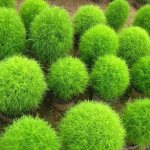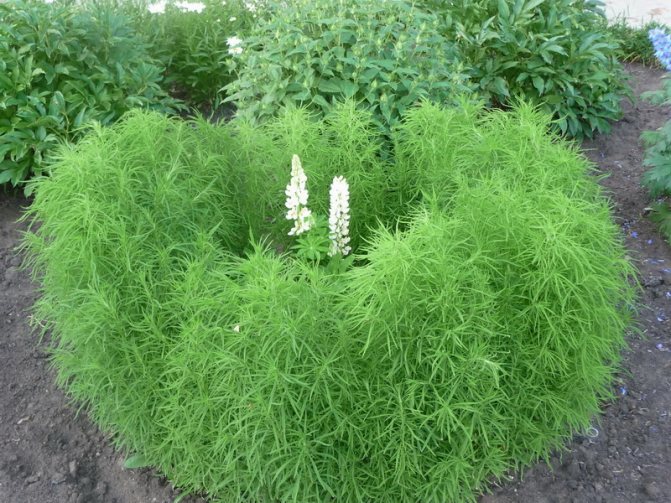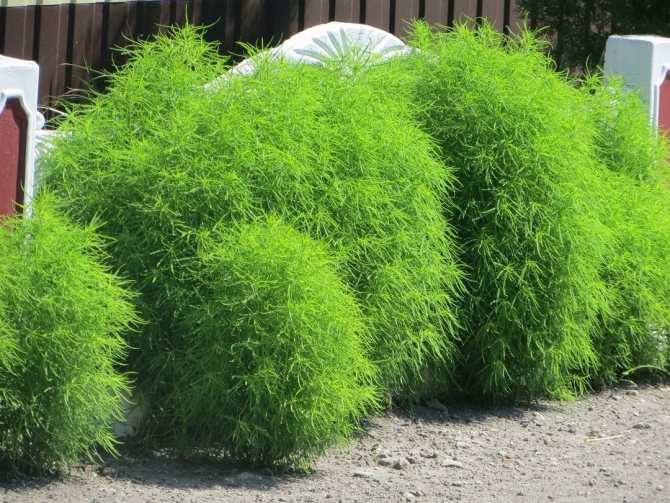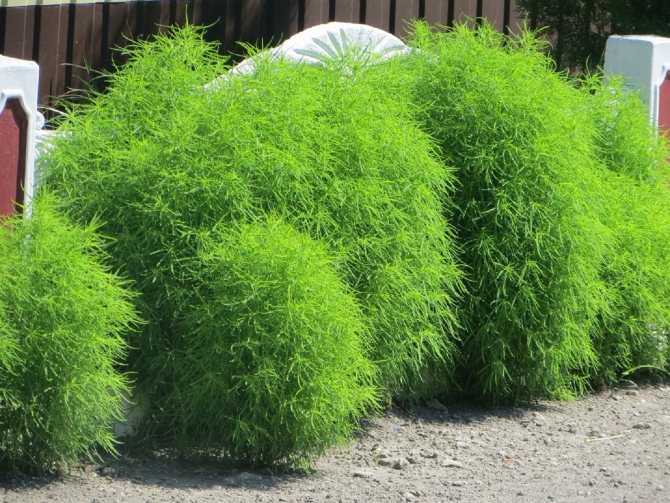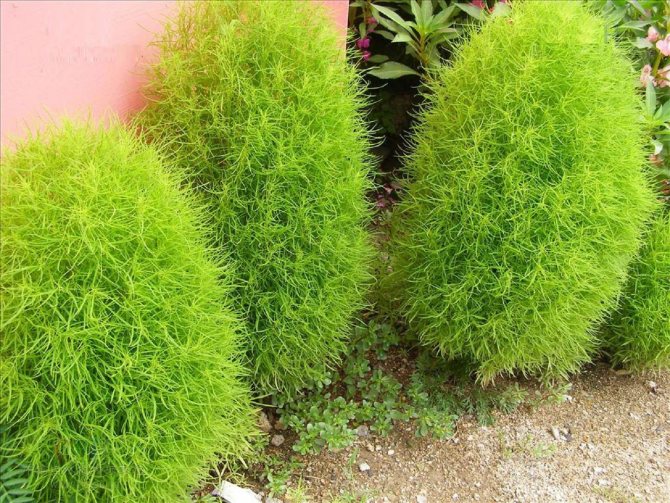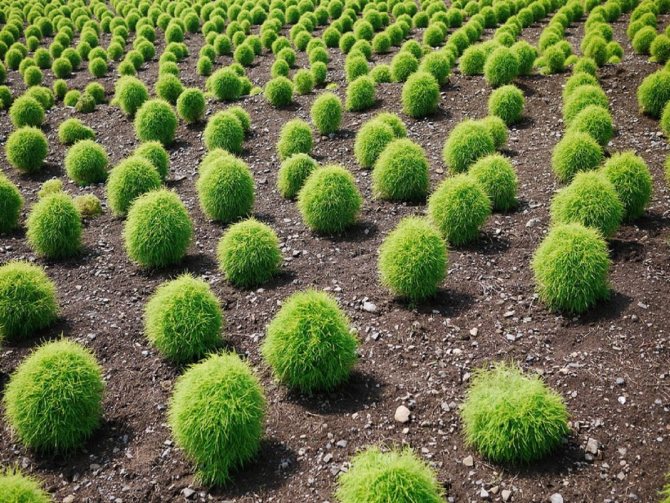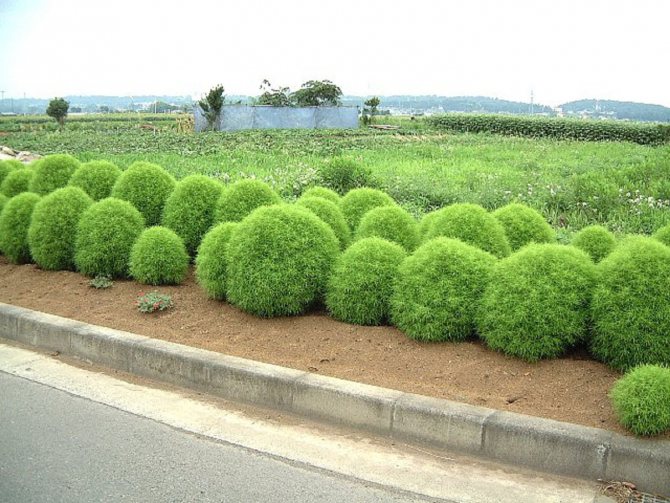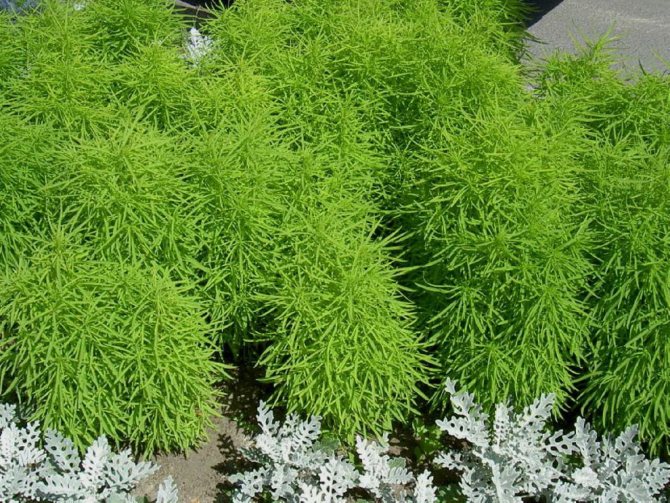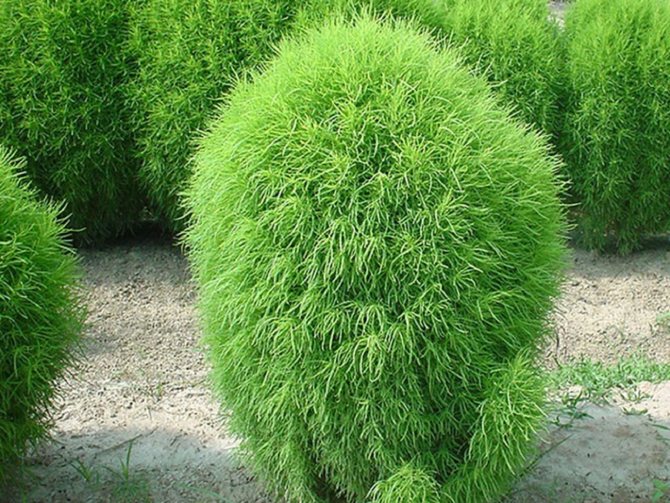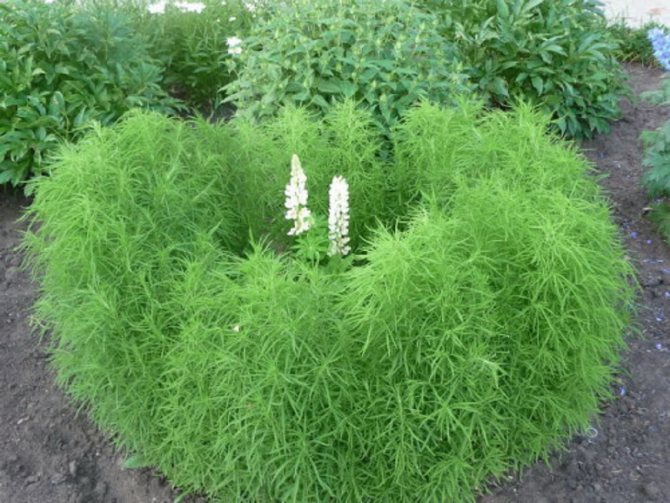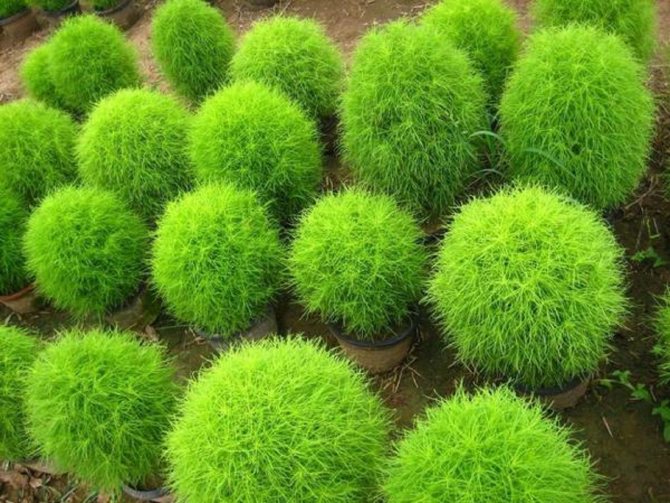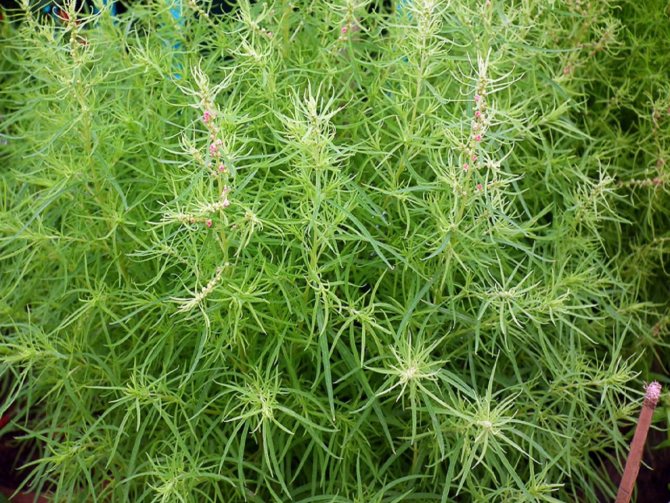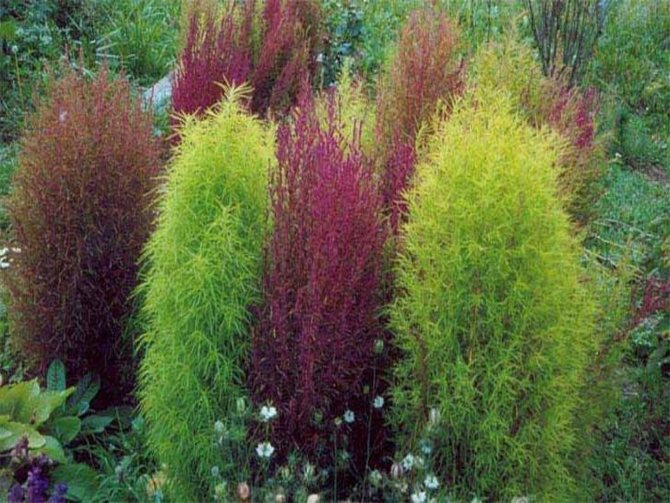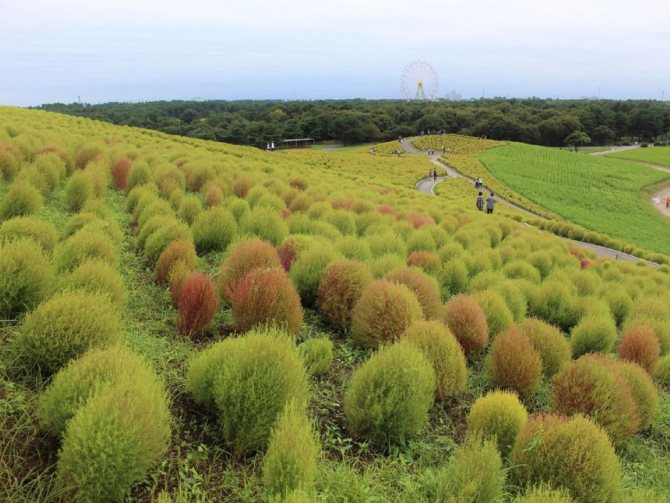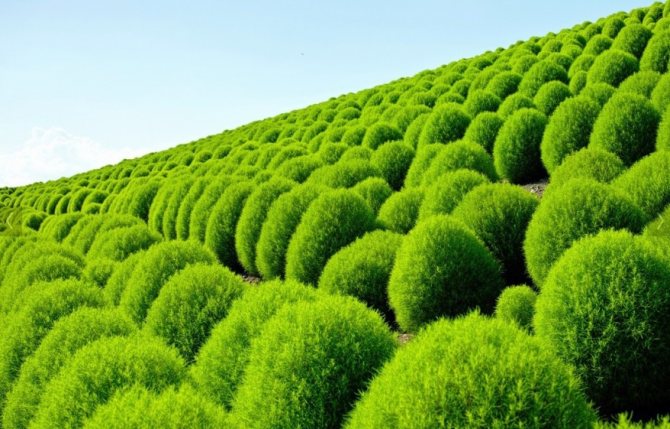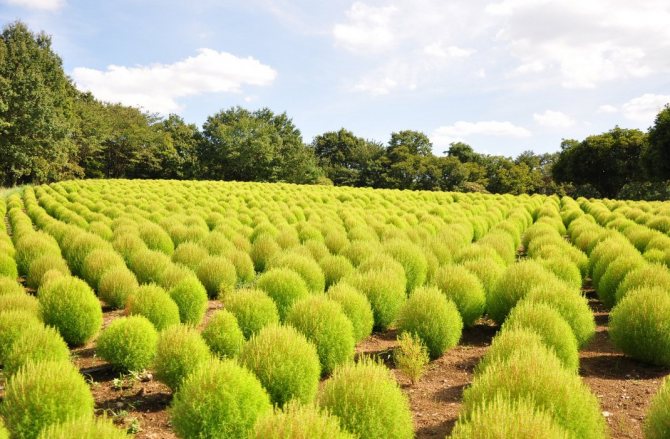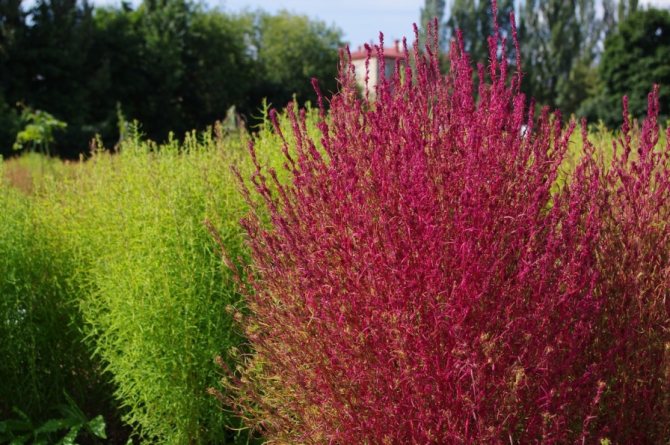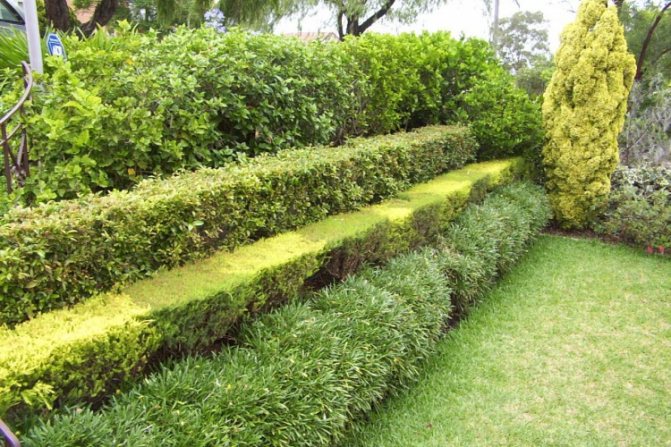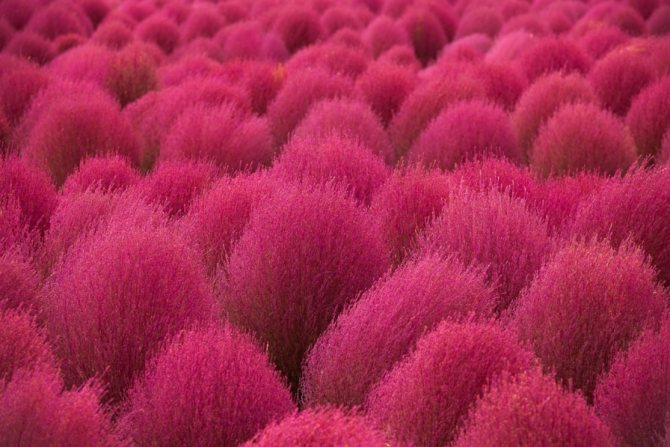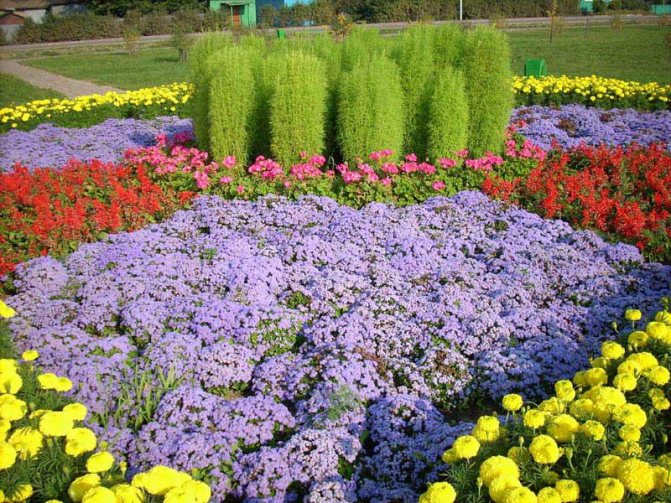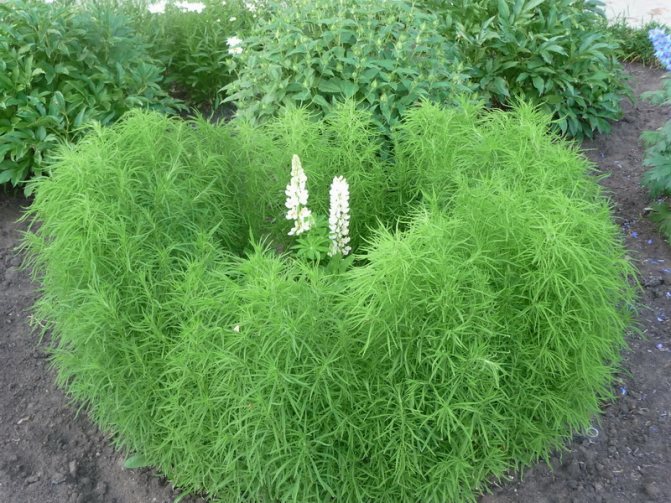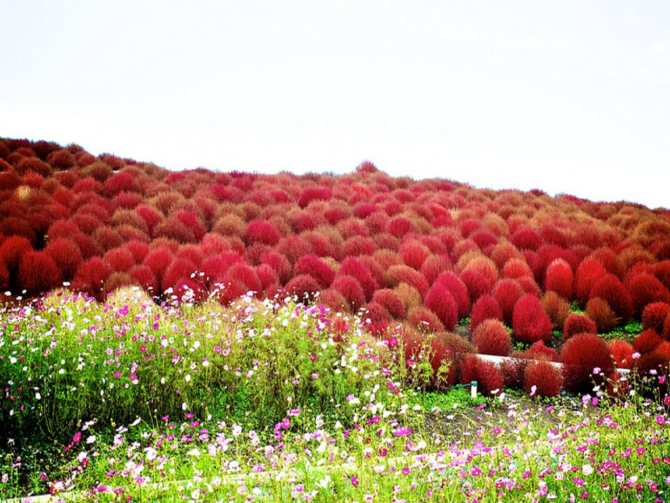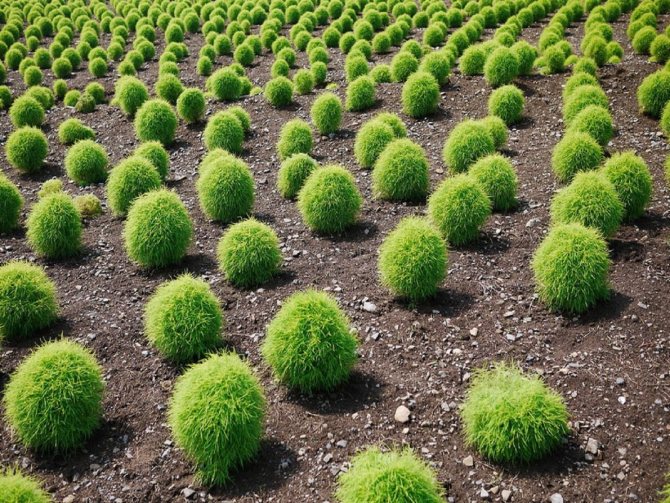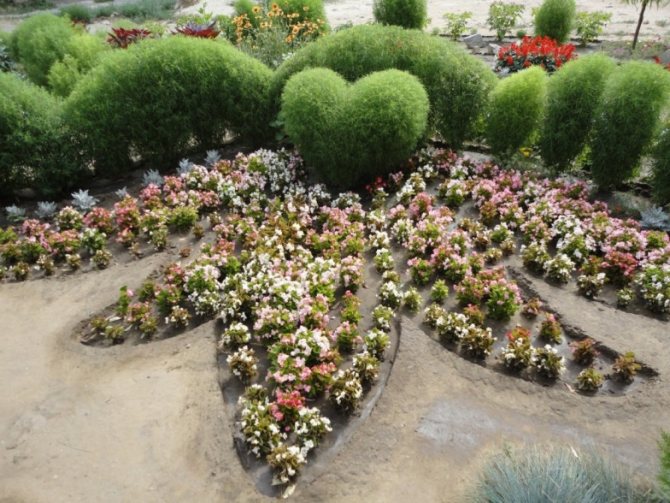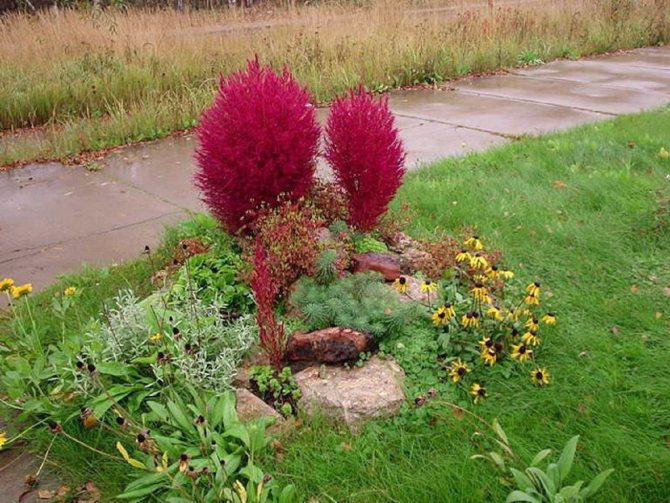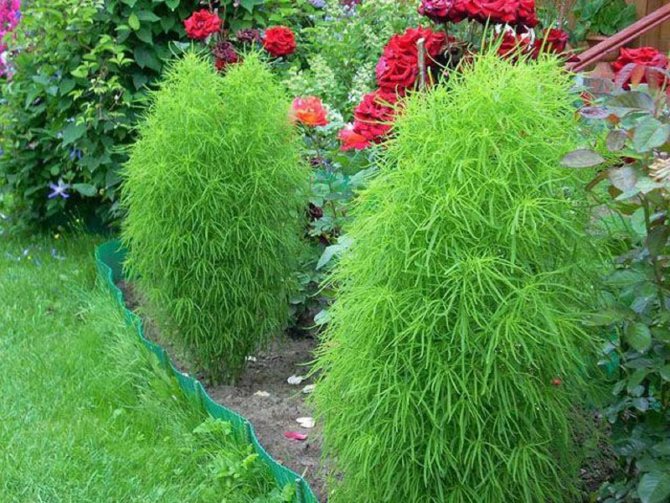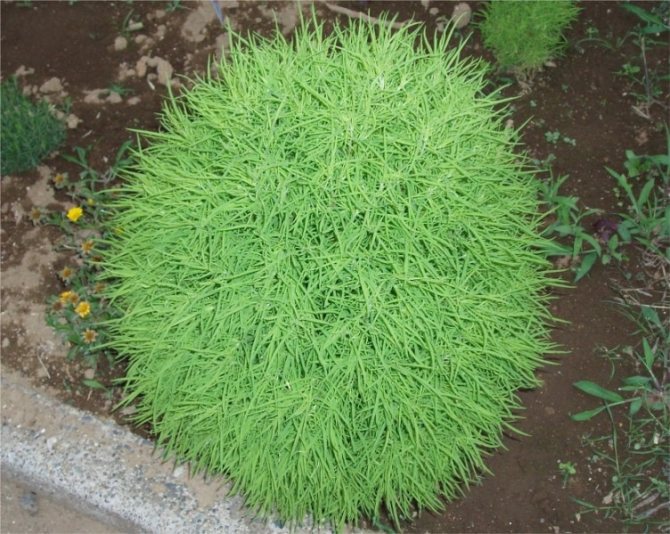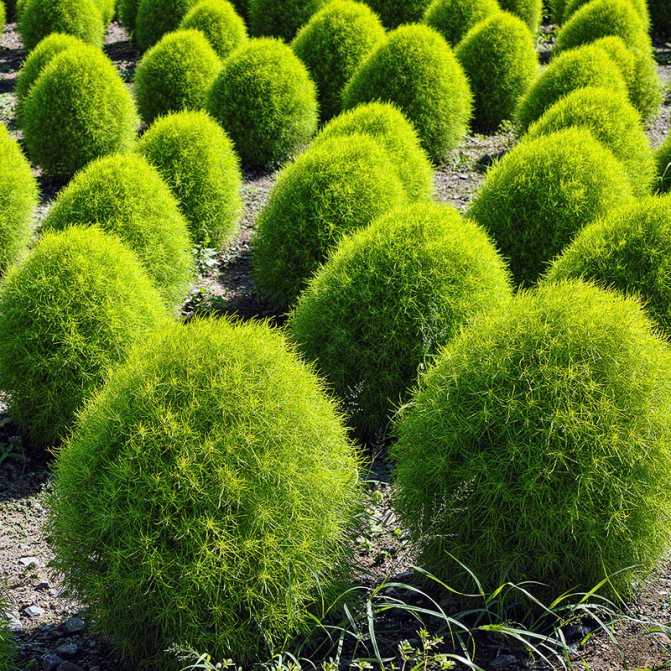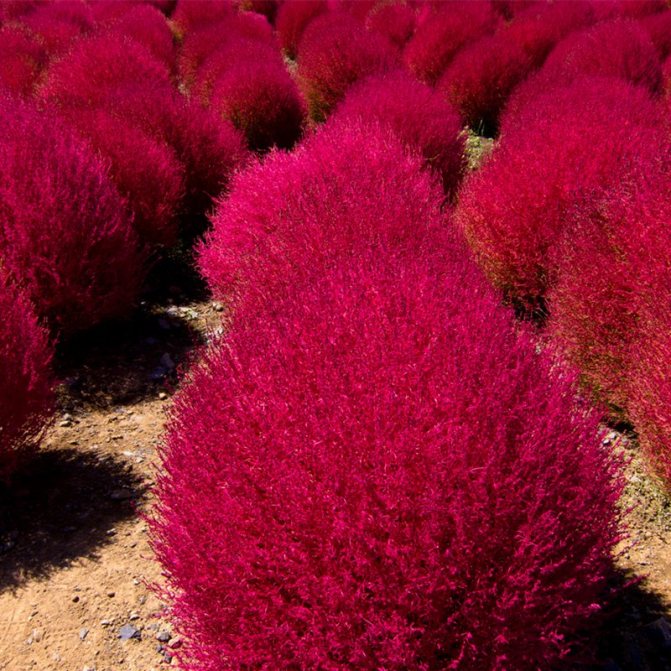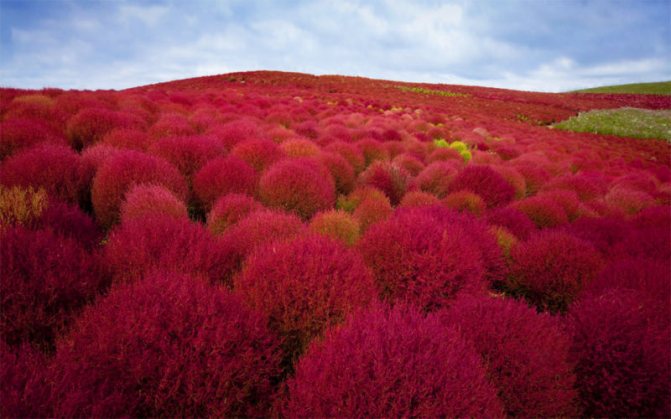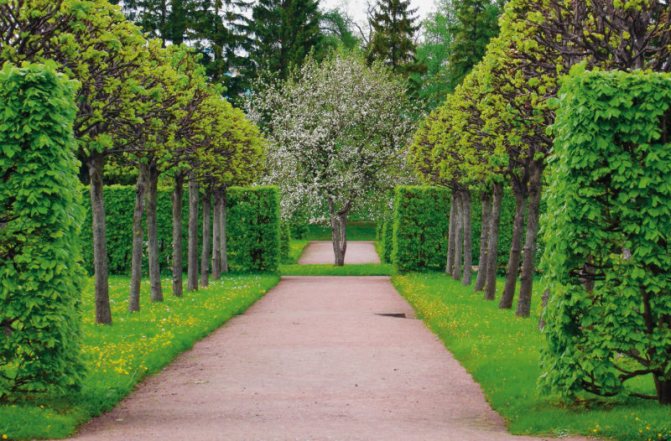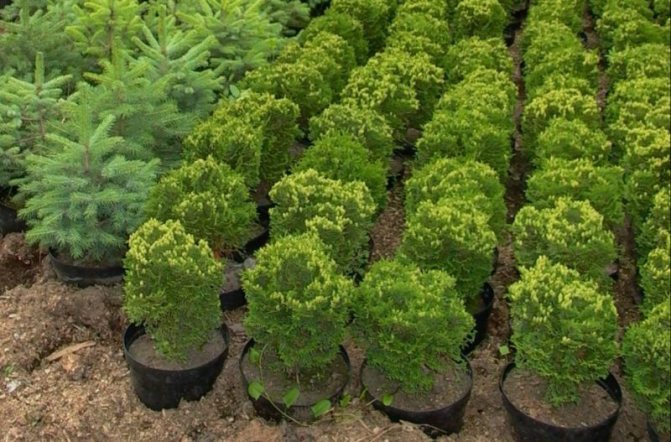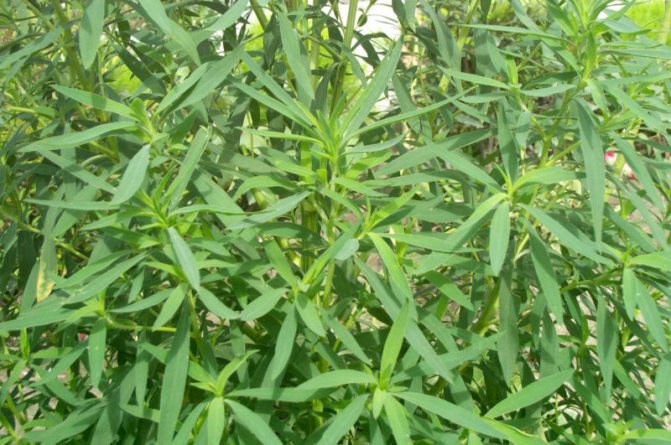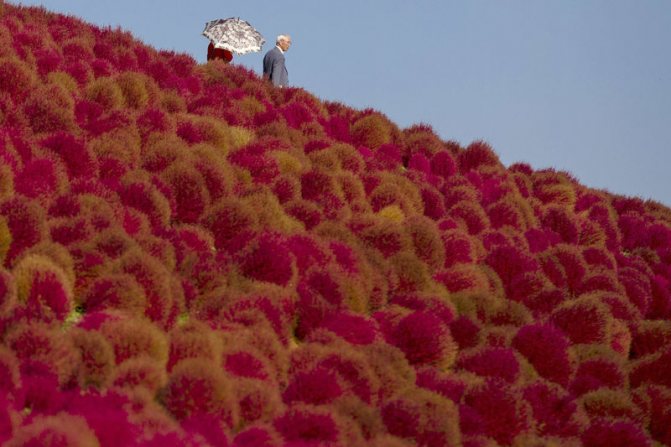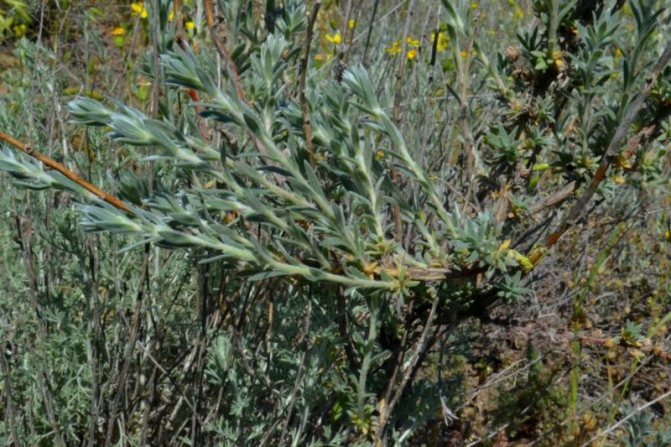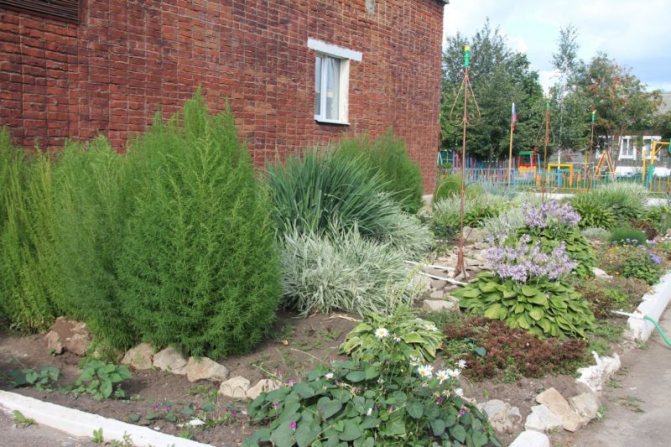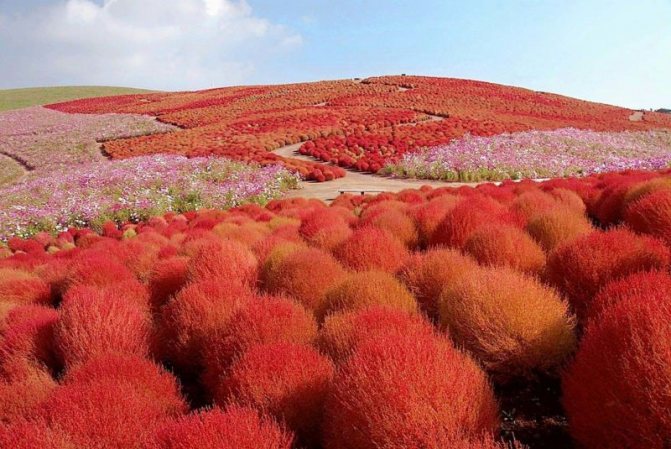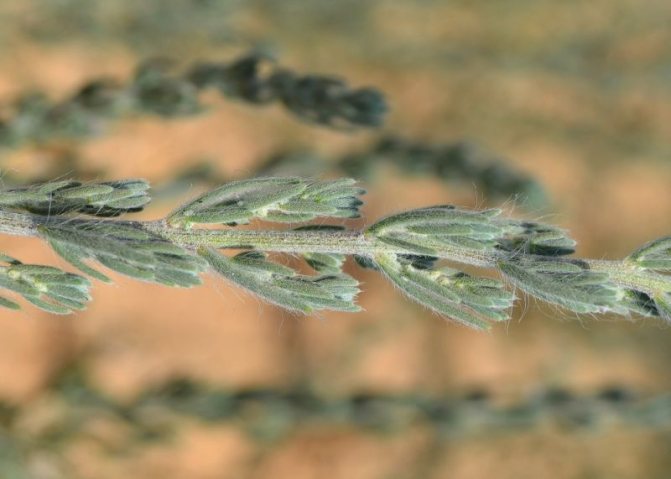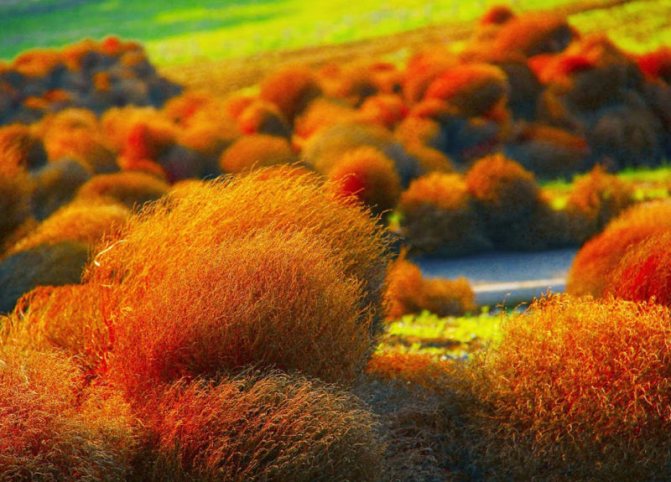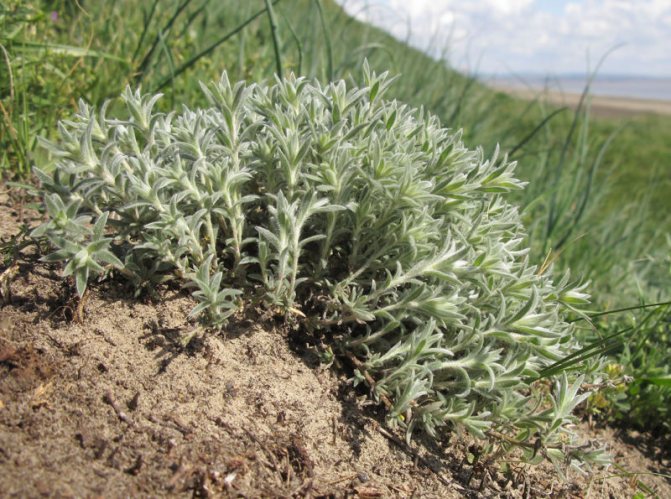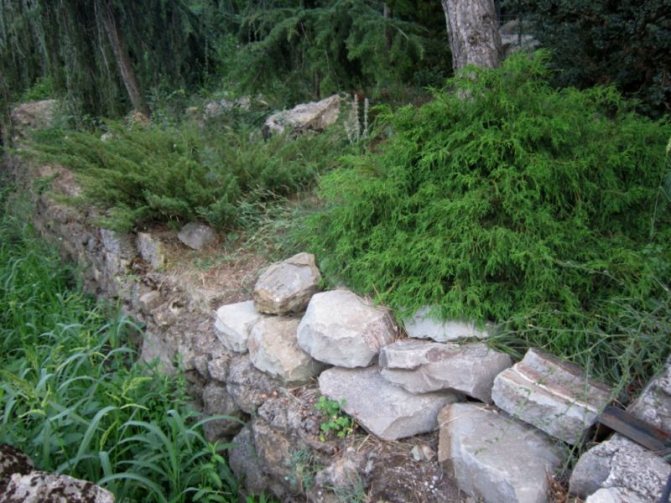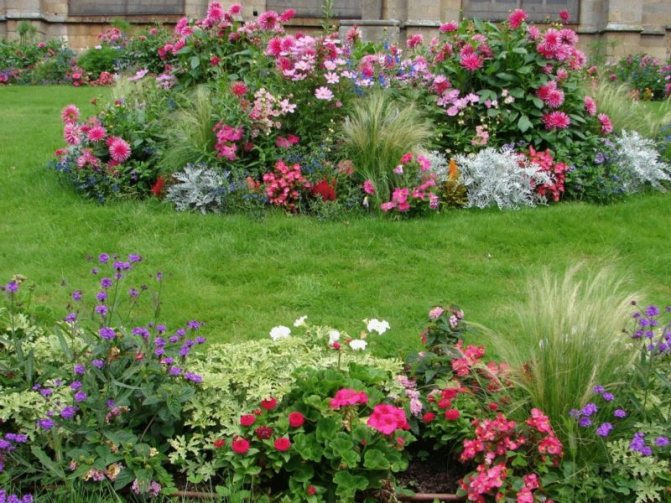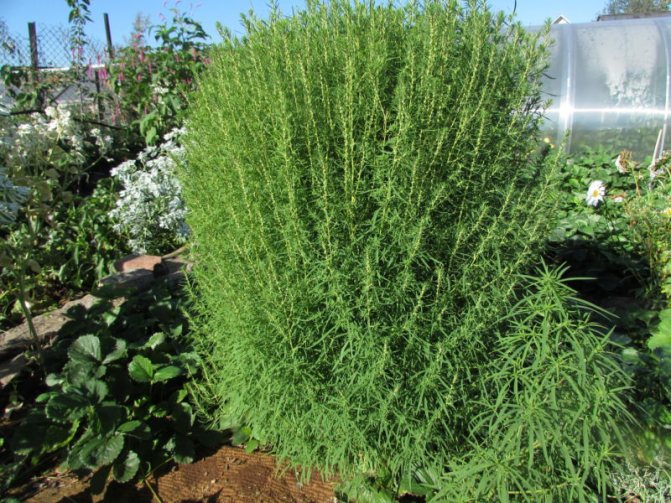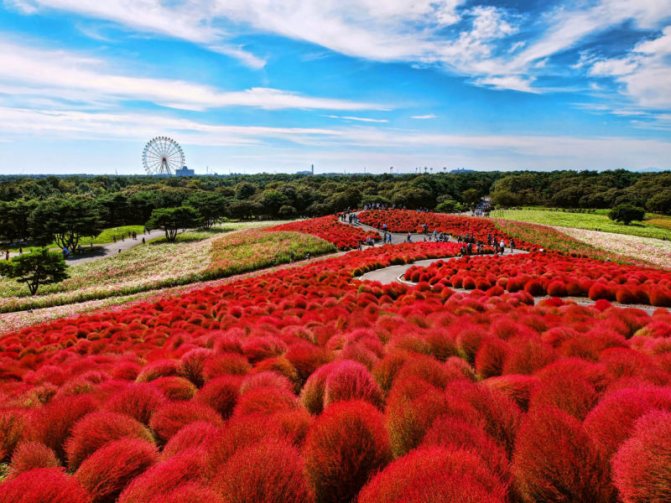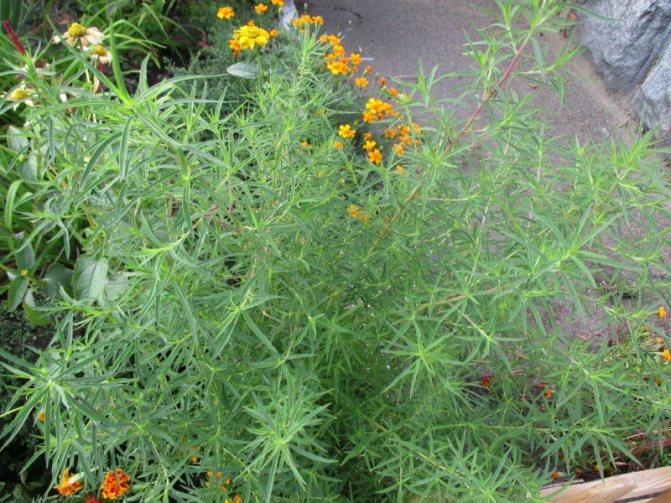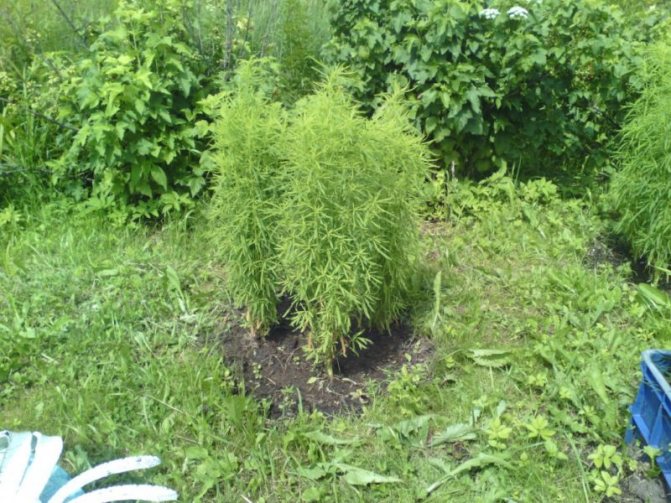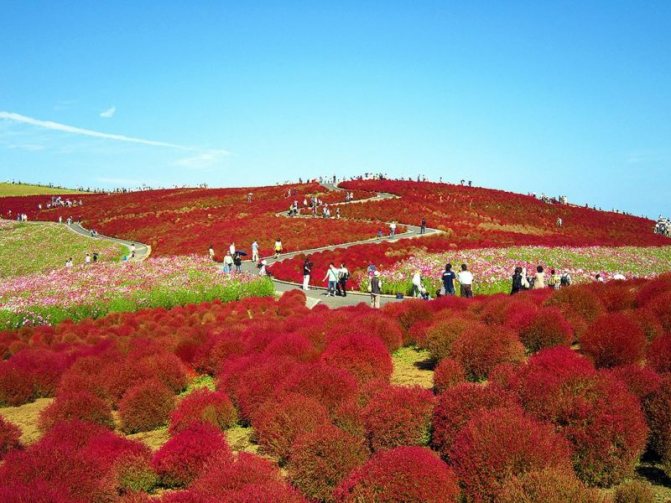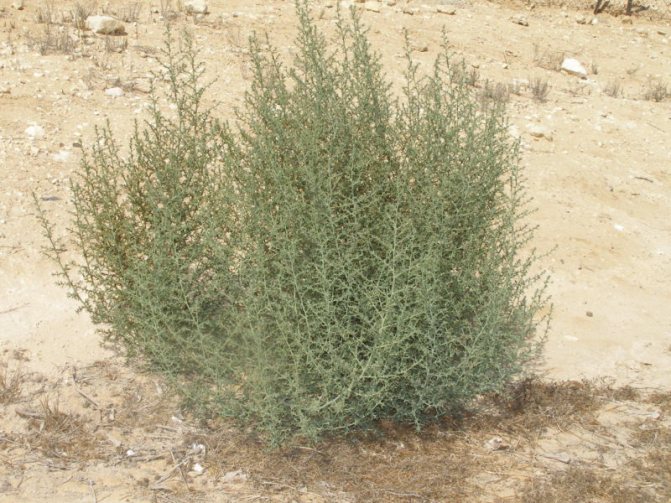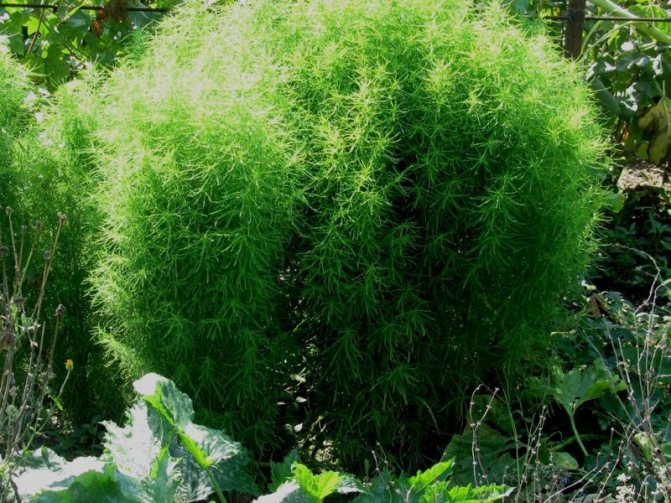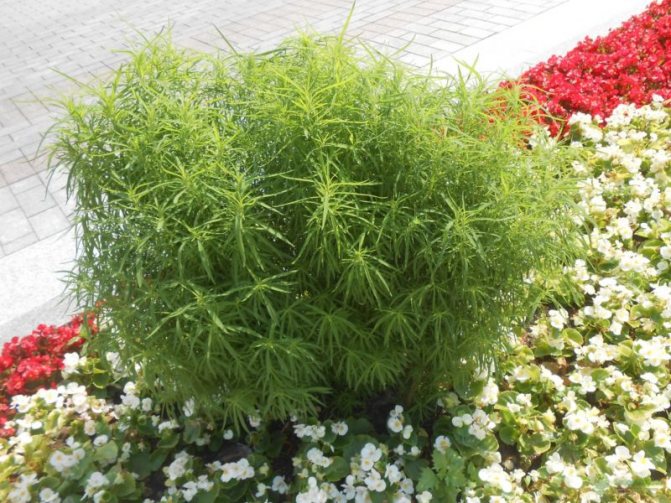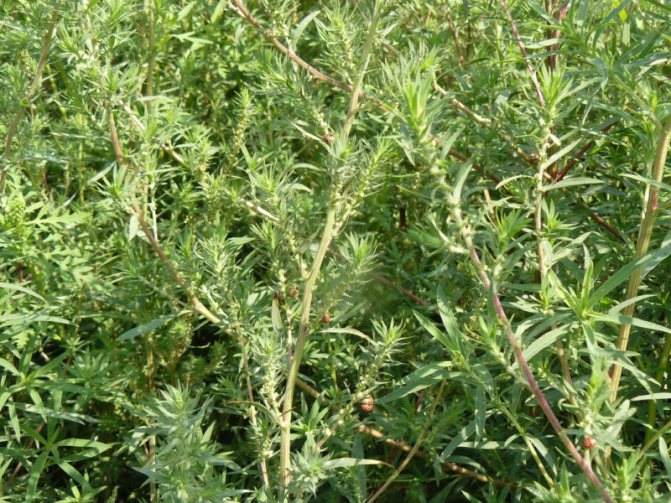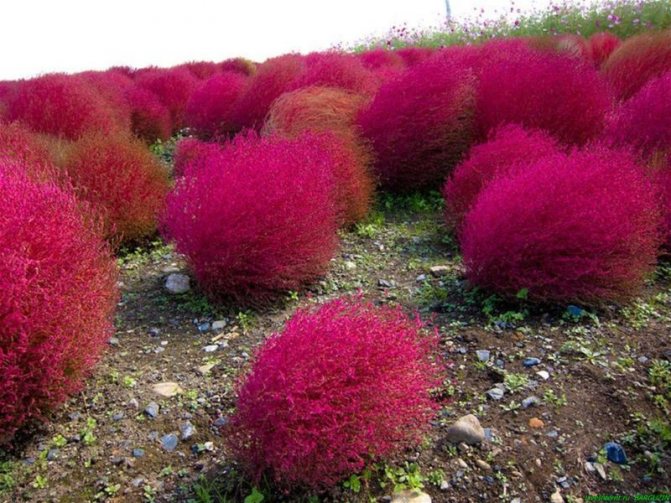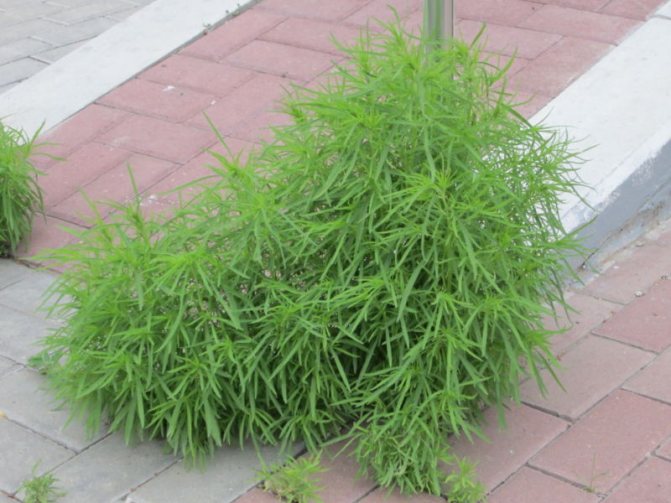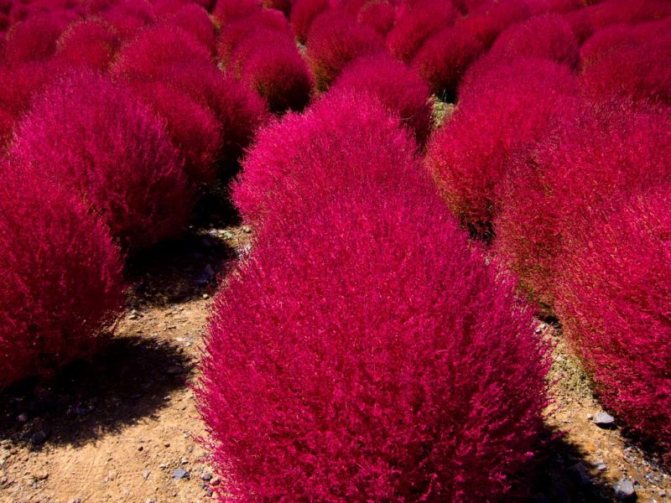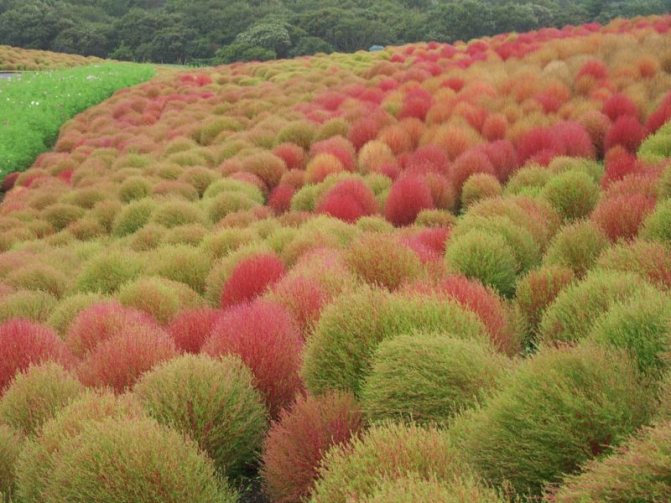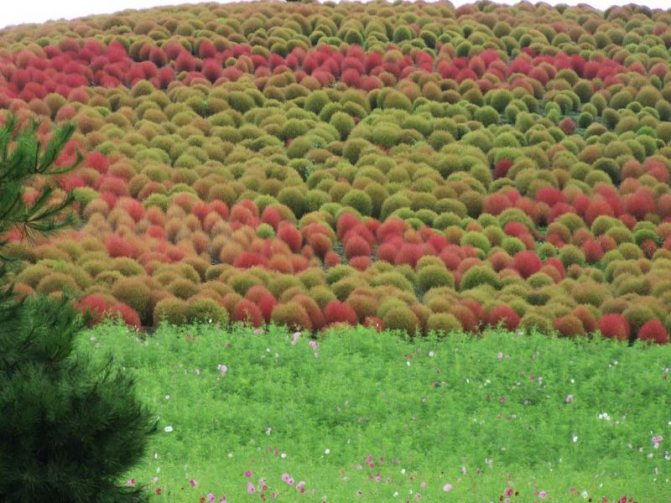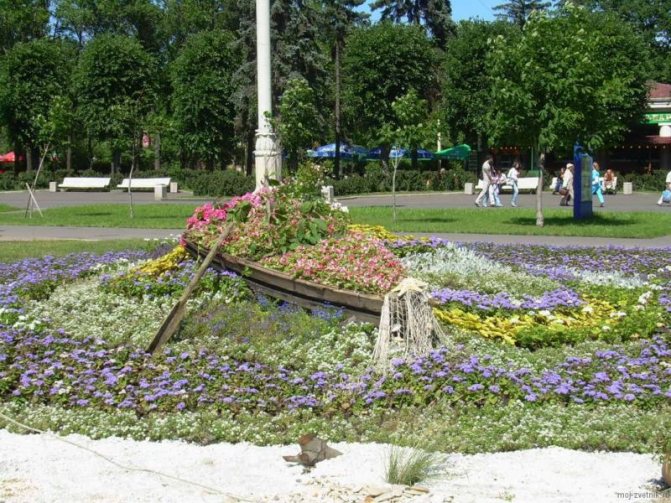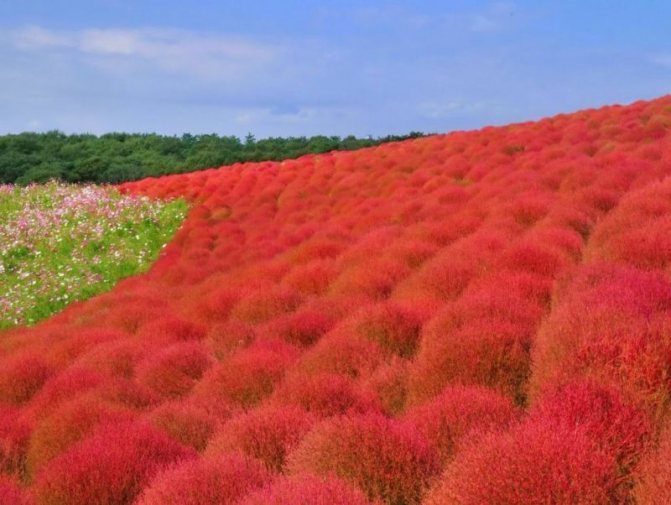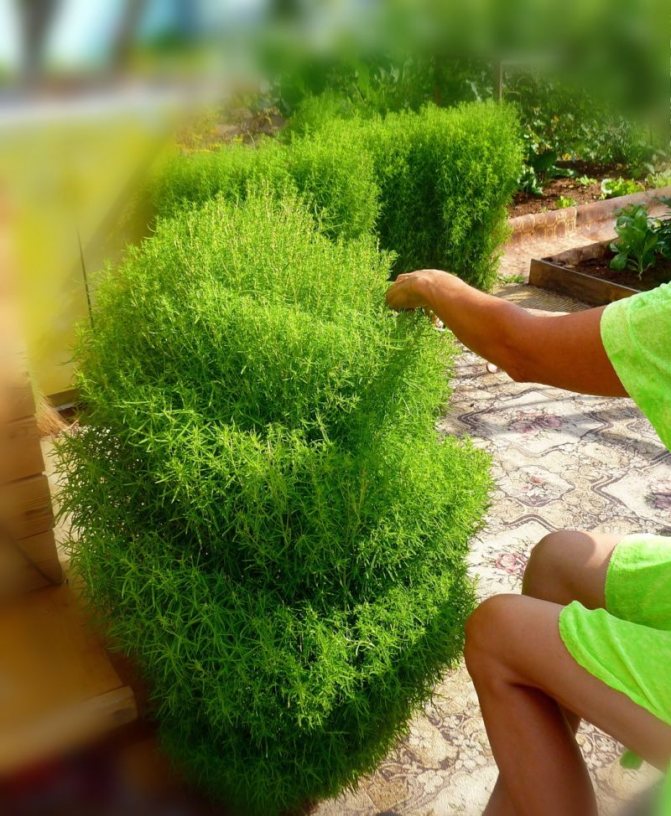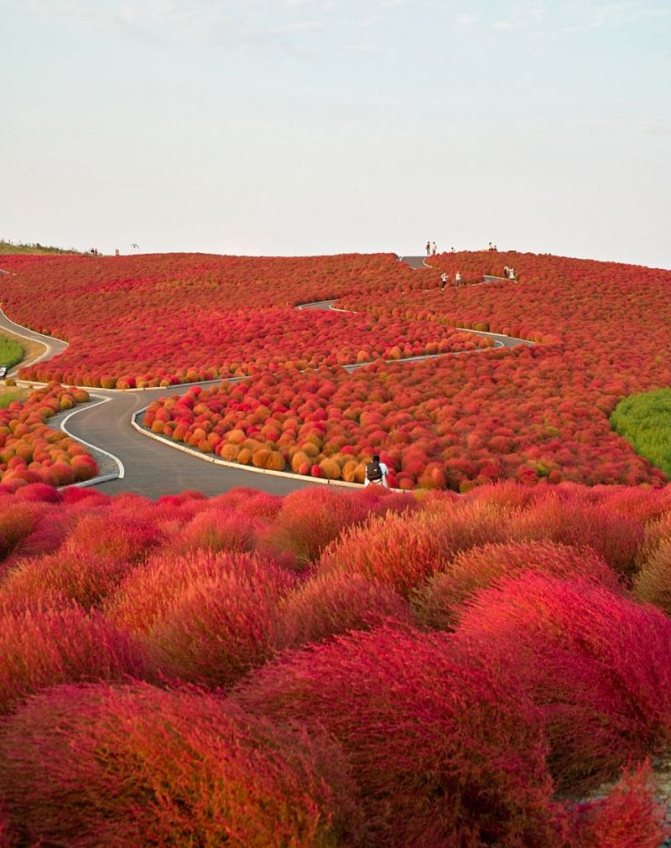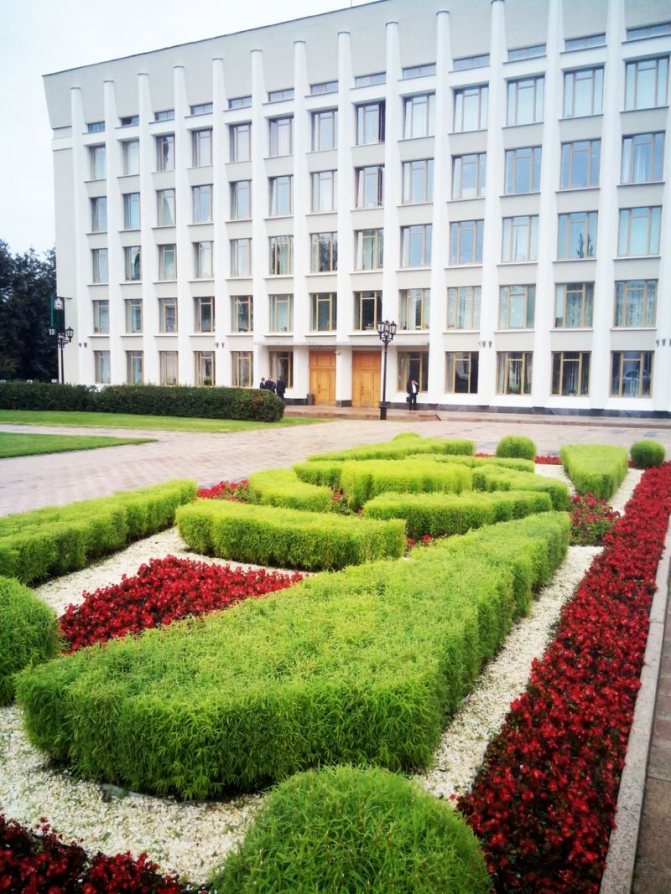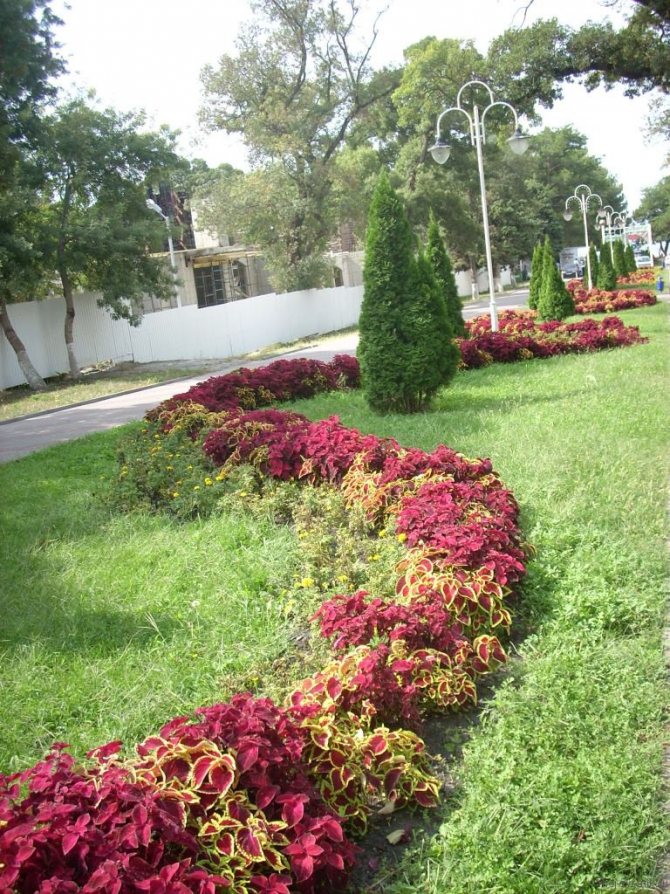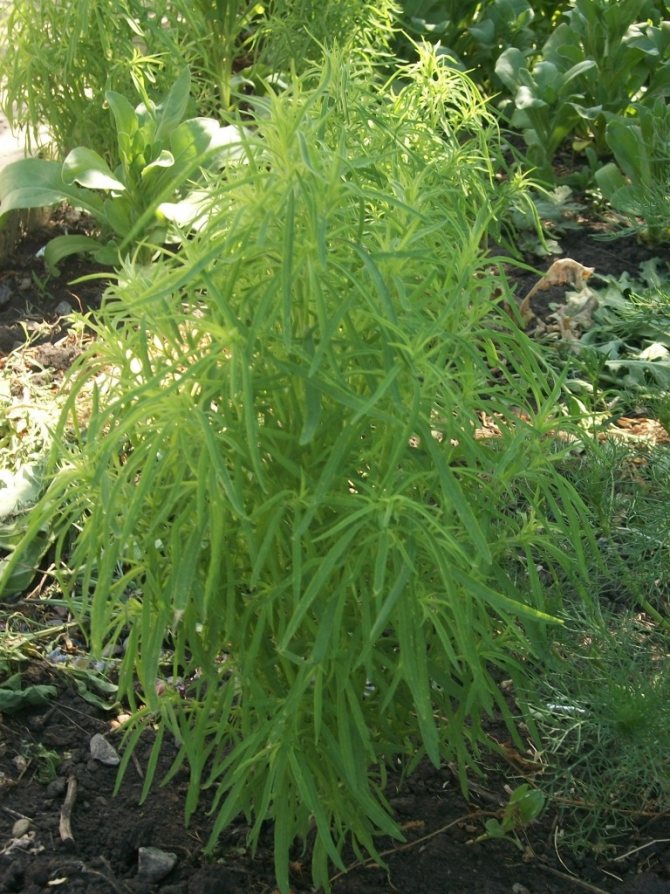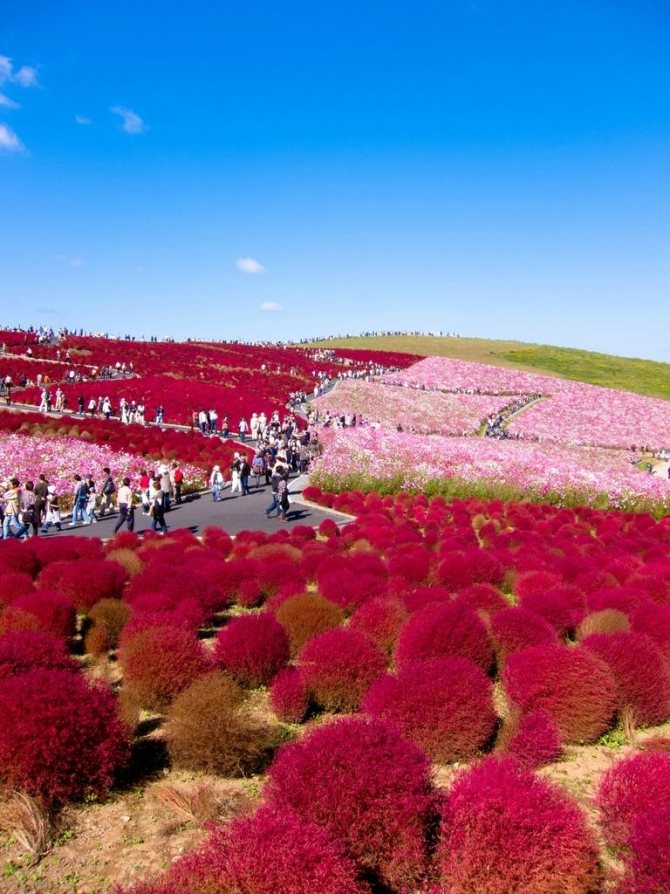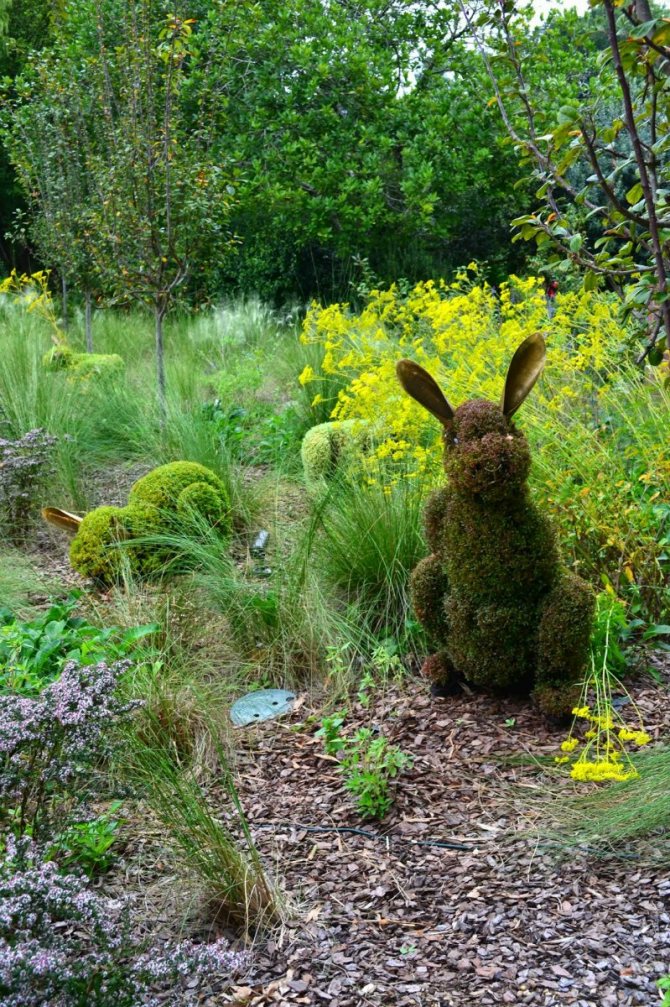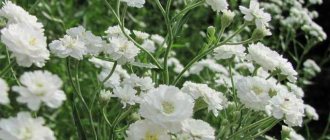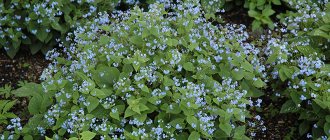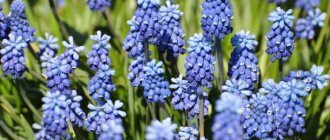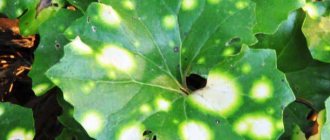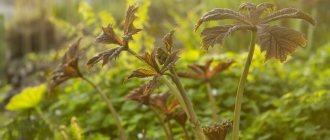Annual cypress is the name of a unique plant that looks like a fluffy ball. At different times of the year, the shade of the stems and leaves of Kohia changes: in the spring there are delicate, bright greens, in the summer - a combination of yellow and orange colors, in the fall purple colors delight.
It is no coincidence that Trichophylla or Cochia is in the top ten of the most interesting and beautiful species in many ratings. Planting and care in the open field is within the power of even novice growers. There are a few "little tricks" to keep the spectacular appearance of an annual cypress for longer. The article describes the nuances of care, cultivation and reproduction of a highly ornamental plant.
Cochia: description
Kohia, planting and caring for which is quite simple, is a shrub belonging to the "haze" family. This plant is highly branched, fast-growing, with narrow small leaves resembling cypress needles. The flowers do not have any particular decorative value. They are rather small and inconspicuous, hiding in the axils of leaves, which, in turn, are light green or bright green. In autumn, the leaves are transformed and, depending on the variety, acquire an orange or reddish tint.
There is a perennial kochia, planting and caring for which practically does not differ from an annual one. True, after a while this plant still degenerates, after which it will be necessary to acquire other seeds and repeat the entire planting procedure.
Kohia perfectly tolerates haircuts and keeps its shape for a long time. Using ordinary scissors from a plant, you can create unique shapes. Skillful hands, armed with pruning shears, are able to give a curb of kochia bushes an oval, rectangular or jagged shape. A single bush can be easily cut in the form of a ball, oval, column or nesting doll, and a group of plants can be transformed into a disk or vase with flowers rising in the middle.
It is very interesting that at the end of summer they are able not only to maintain a given shape, but also to fantastically paint in variegated, crimson-brown, green-pink colors, creating their own original patterns on each figure. You can also plant kochia in the center of the flower bed or among the plants, decorate the garden with a trimmed border.
After the kochia flowers, planting and caring for which are described below, have been cut, they need a little recharge. In this case, the plant needs special nitrogen fertilizers, which are recommended to be applied in liquid form.
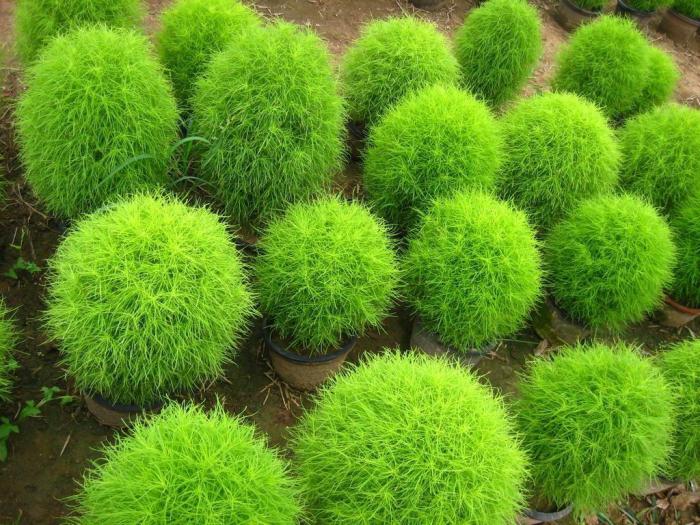
The healing properties of kohija
Along with decorative properties, kochia has medicinal and forage value. The shoots and seeds of the plant are used as folk remedies. In a dried form, on the basis of raw materials, decoctions are prepared and tinctures are made on alcohol. Drugs made from parts of perennials have diaphoretic, stimulating, bactericidal, laxative and diuretic effects.
Preparations containing cochia substances stop the spread of eczema, erysipelas, and gonorrhea. Eastern healers have learned how to make a cream from the leaves, which strengthens the nails and skin.
Young shoots are used to feed livestock, and the foliage of kochia is considered edible and in some countries is used for culinary purposes.
Garden flowers Annual and biennial flowers
Kohia: planting and care
Cochia is most often used to decorate summer cottages in those places where you can make a small hedge from a plant and very unusual figures by cutting branches. The beauty of such a shrub cannot leave anyone indifferent. Also, kochia, planting and caring for which does not require much effort, can be grown near the house or plot.
Those who decide to plant kohija should know that it cannot stand shade and frost. The plant prefers sunny and bright places, but it can grow in partial shade. Cochia can be grown on any soil, but the plant thrives best on non-acidic and fertile soils. The shrub is able to tolerate a short drought well, in addition, it does not need frequent watering.
Cochia is most often grown by planting seeds directly into the ground. They are planted in the ground both in the spring and in the fall. But this method is not the best for flower cultivation. It is best if seedlings are grown from seeds, and only then transplanted to a permanent place.
Protection from pests and diseases
The main problem at the seedling stage is the development of a dangerous disease called "black leg". Rotting begins in the zone of the root collar with excessive watering, a combination of dampness and low temperatures, waterlogging of "heavy" soil. Improper arrangement of the drainage layer or the absence of holes in the bottom of the container also interfere with the free flow of liquid from the soil after watering the seedlings.
It is not difficult to prevent the problem:
- after the formation of seedlings, reduce the temperature in the room to +15 degrees;
- before planting seeds, it is imperative to treat the soil with disinfectants (potassium permanganate solution) or fungicides;
- water the seedlings moderately, avoid stagnation of water in the container.
With the development of the "black leg":
- remove damaged seedlings;
- sprinkle the surface of the soil with perlite, charcoal or calcined fine sand to remove excess moisture;
- with the active spread of the disease, a thorough treatment is carried out using fungicides. Antifungal agents are used according to the instructions;
- for better treatment of damaged elements, reducing the risk of developing new spores, not only greens are treated, but also the soil in the growth zone. The same rule applies to the fight against fungus on adult shrubs;
- effective drugs for the treatment of mycoses: Fundazol, Bordeaux liquid, Skor, Fitosporin;
- it is important to protect the body from the effects of chemicals.
Growing seedlings
Kohia, planting and care of which is carried out by seedlings, is planted at the end of March. To begin with, you need to prepare seedling boxes, or containers and fertile soil. Then scatter the purchased seeds over the surface of the ground and sprinkle lightly, then moisten.
After that, you need to put the boxes in a sunny place, away from batteries and other heating appliances. At the end of planting the seeds, they must be sprayed daily with water (but not watered).
After the seeds sprout and the threat of frost has passed, the plants are planted in the ground in a permanent place. Kokhia should be planted in the most suitable conditions for it, that is, in those places where there is less shade. The distance between the bushes should be 10-15 cm. From the first days, special supports should be organized for the seedlings.
Cochia next year will be able to reproduce by self-seeding. To do this, you just need to leave a few bushes for the winter. In spring, young bright green shoots will appear near these flowers.
Reproduction
Unlike many types of ornamental plants, only seeds are needed to breed kochia. Planting material is harvested at the end of flowering and ripening of fruits on the site or purchased in specialized stores.It is important to choose a quality base with a suitable shelf life: even with "fresh" seeds, germination is far from ideal.
Summer cypress is grown only through seedlings. How to do it? Answers with a detailed description are in the previous sections. It is important not to delay sowing seeds: April is the optimal period for starting work.
Cochia: planting and care in the open field
Today, kochia is planted in several ways at once, which allow you to equally get a strong and healthy plant. Since seedlings and seedlings grow quickly indoors, they are recommended to be sown in the first week of April. Most experts advise to introduce seed into the soil, which is later covered with cellophane or special frames with glass. In addition, some growers plant kochia with seeds directly into the ground, since it is a very frost-resistant plant.
Growing kochia from seeds
Cochia is grown using seeds. The material is planted in advance to obtain seedlings or immersed directly into the ground. To remove seedlings, sowing is carried out in March-April. For sowing, prepare wooden boxes with garden soil mixed with sand. Before pouring the earth, it is calcined. The soil is sprayed with water and the seeds are spread in a thin layer on top. It is not necessary to sprinkle the seeds, you can just lightly press them into the soil. Containers with seedlings are stored at room temperature. Good lighting is essential for successful germination.
When the seedlings wake up, the boxes are transferred to a cool place. When three leaves appear on the sprouts, the seedlings dive into other pots. It is better not to plant more than three seedlings in one pot. In May, after the spring frosts leave, the grown seedlings are sent to the open ground. Since the plant tends to grow, intervals of at least 30 cm are made between individual seedlings when planting.
Kokhia seeds are also sown directly into the ground, bypassing the seedling stage. This method is suitable for southern regions. Sowing is done in May or October so that the kochia can germinate immediately after the snow melts. Before immersing the seeds in the soil, the flower garden is dug up, enriched with peat and sand. Seeds are scattered over the dug area and sprayed with water. The first green shoots break through the soil after 10-12 days.
Cochia care
Cochia belongs to a rather unpretentious and picky plant to the soil and growing conditions, which attracts its admirers very much. For rapid growth, active care and the creation of unusual conditions are not required. By itself, a flower planted in the sun grows and develops well, even if watering is not carried out for a long time. In addition, the plant is indifferent to the composition and fertilization of the soil, as well as to weeding and loosening the soil. You can, of course, take care of the plant in this way, but without such care it will feel good enough in the garden and will certainly create a beautiful landscape.
Cochia is very popular with all lovers of conifers, as its appearance visually resembles an unusual overseas small Christmas tree. This is what attracts some amateur gardeners who want to diversify their site with an unusual and beautiful plant.
Alternatively, you can try growing kochia by sowing seeds directly into the soil. Even though not all kochia seeds will grow in this case, this is a real way to save your time and energy. This way, your kochia can appear in the garden without any effort at all, which is especially attractive for urban nature lovers.
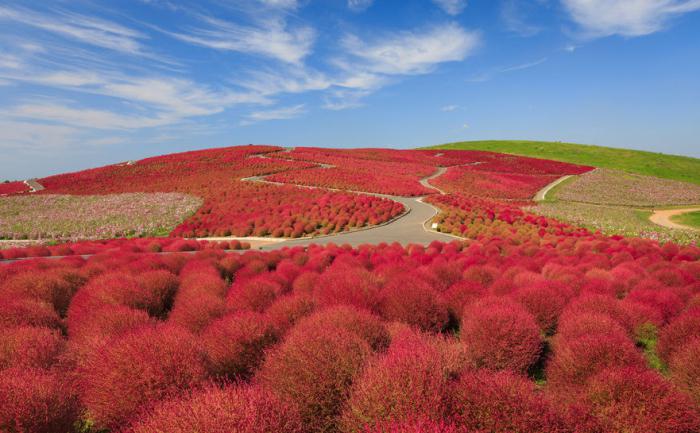

Kokhia species
Cochia broom (panicle), most often used in landscape design, has two varieties:
- Cochia hairy (K. Scoparia var.Trichophylla) with thick green leaves that turn brownish-red in the autumn months. The shrub grows up to 1 m in height.
- Cochia Childs (K. Scoparia var. Childsii) during the whole warm season retains its green color. Bushes are compact, low. The maximum plant height is 60 cm.
Less commonly in landscape design, you can find other annual types of cochia: woolly ((K. Laniflora)) and dense-flowered (K. Densiflora).
Cochia woolly-flowered... It got its name from the curly short hairs that cover the stems. Plants of this species grow in height up to 60-80 cm.
Cochia dense-flowered... Tall view, up to 130 cm tall with horizontal shoots. It is of interest in flowering form, the flowers have long white hairs at the base, giving the shoots a slight pubescence.
Cochia creeping or izen (K.Prostata) is a perennial plant. It is not widely used in ornamental gardening, but sometimes it can be planted in rock gardens and rockeries.
Cochia creeping has branched shoots creeping along the ground and at the ends curving upwards. Height above ground 10-50 cm. Young shoots are covered with silky hairs, eventually become smooth. The leaves are threadlike, smooth or fluffy.
Care features
Caring for kochia is not difficult, but it requires compliance with certain rules that allow you to grow a lush and highly decorative plant:
- the introduction of fertilizers, namely, diluted humus, stimulates the branching of the aboveground part;
- watering is necessary for ornamental crops in especially dry periods;
- trimming an adult plant is not difficult, the aerial part can be formed in the form of a pyramid, ball, egg or column;
- when properly pruned with garden shears, the plant is able to maintain its shape for a long time.
Care should be taken to protect the kochii from strong gusty winds and drafts, creating denser plantings in areas exposed to them.
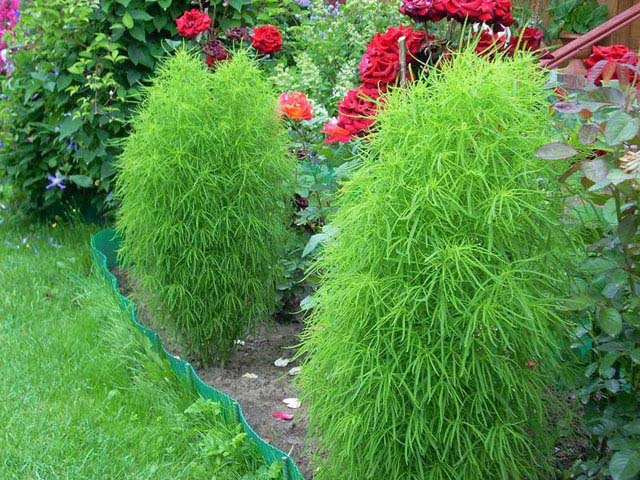

Botanical description
Cochia is a perennial or annual ornamental crop with a rapidly growing crown. The genus includes herbaceous and semi-shrub forms. They acquire an attractive appearance already at the beginning of June and persist until the first frost. The average height of the kochia is 60-80 cm. It consists of many thin, highly branched shoots along the entire length. At the base is an erect woody stem.
Some people, when they first see kochia, attribute it to conifers. The reason for this is the very narrow leaves that resemble needles. However, the foliage, like the upper part of the shoots, is very soft and pleasant to the touch. Narrow leaves have short pubescence. Young kochii are covered with light green, emerald leaves, but within a few months they change to pink and crimson.
In addition to decorative leaves, kochia has flowers, but tiny buds do not attract attention. They gather in paniculate inflorescences in the axils of the apical leaves. After pollination, miniature nuts ripen. Each carries only one seed, which remains viable for two years.
Compatibility with other plants
As mentioned above, kohija is perfectly combined with other plants, its ability to create a stunningly bright and rich background color allows you to incredibly beautifully emphasize individual elements. So, for example, in the narrow labyrinths of kochia, such beautifully flowering flowers will look great, such as: "Soaring Fairy Acidantera", "Allamanda", "Pavonia", "Mandeville" and others. Especially colorfully, it emphasizes the edges of garden and park paths, while often in parallel are various low-growing flowers, such as: "Calceolaria", "Ageratums", "Marigolds", "Gatsania" and so on.
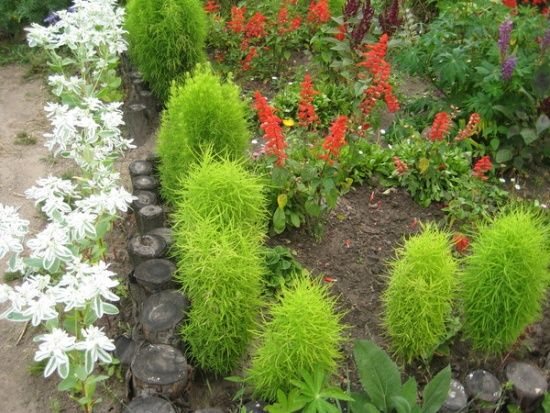

Various compositions are very well combined with interior items, which include dry sprigs of kochii, usually they are processed to give either an original or classic composition for such compositions using white kochii sprigs. Thanks to the original trunks, the twigs add splendor and airiness to compositions from dried bouquets, which are often elements of interior decor.
Planting kochia seedlings
When to plant the seeds of this plant in order to further grow seedlings depends on the climate prevailing in the area where you live. So, if it is standard, which is called Central Russian, it is time to sow by the end of March. The maximum frost of the soil can be at the beginning of May. To prepare for the procedure and sow the seeds, follow some instructions:
- First, you need to prepare containers with a depth of at least twelve centimeters. The most optimal sizes will be 25 by 25 or rectangular 20 by 40.
- These containers must be thoroughly disinfected. Therefore, rinse them thoroughly under hot water, using laundry soap, then rinse with an intensive solution prepared in a composition with potassium permanganate.
- The soil must be prepared on its own using fine peat together with fine river sand. You can also add humus or perlite in a small amount to the composition.
- Also, the soil must be disinfected before planting the plants. This is done by heating, or again using a heated solution with potassium permanganate.
- Smooth out the soil, tamp with a plank and then moisten.
- You should also tamp the ground before sowing the seeds.
- Seed should be spread evenly over the surface of the soil, keeping a sparse distance.
- Sprinkle the seeds on top with a thin sandy layer.
- Moisten it again using a spray bottle.
- Cover with a special white protective material.
- After all, set your future seedlings to light, and also observe the temperature regime within eighteen - twenty degrees Celsius.
Popular varieties
Summer cypress. Differs in oval-elongated rather high (75 - 90 cm) bushes. Bright green in summer and crimson red in autumn.
Sultan. Non-high grade (60 cm), round bushes. With the onset of autumn, it turns red.
Green Lace. Elongated bushes, deep green color, changes to red in autumn.
Green forest. Variety with highly branched shoots of light green color. The shape of the bush is correct, oval. It grows up to 90-100 cm.
Trichophyllus. Medium-sized variety (50-80 cm). In summer, numerous leaves have an emerald green color, in autumn they are rich burgundy.
Burning bush. Fast growing bushes with small leaves. Green in summer and bright crimson in autumn.
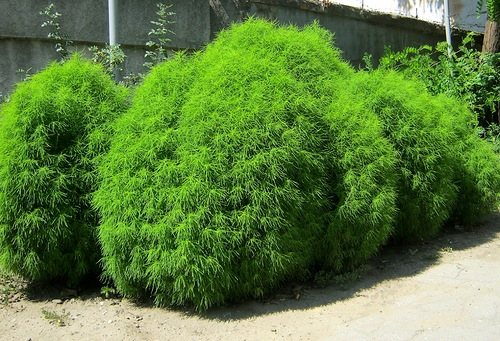

Care. Choosing a landing site. Top dressing.
For me, the most important criterion when choosing plants for a site is their undemanding care and long decorative effect. Kohia is one of those - she is beautiful at any moment of her growth. It grows in my narrow passage between the fence and the house, in the northeast, the sun comes there only early in the morning, besides there is a constant draft, but this does not bother her at all. In addition, it tolerates drought well, and with regular watering it grows by leaps and bounds.
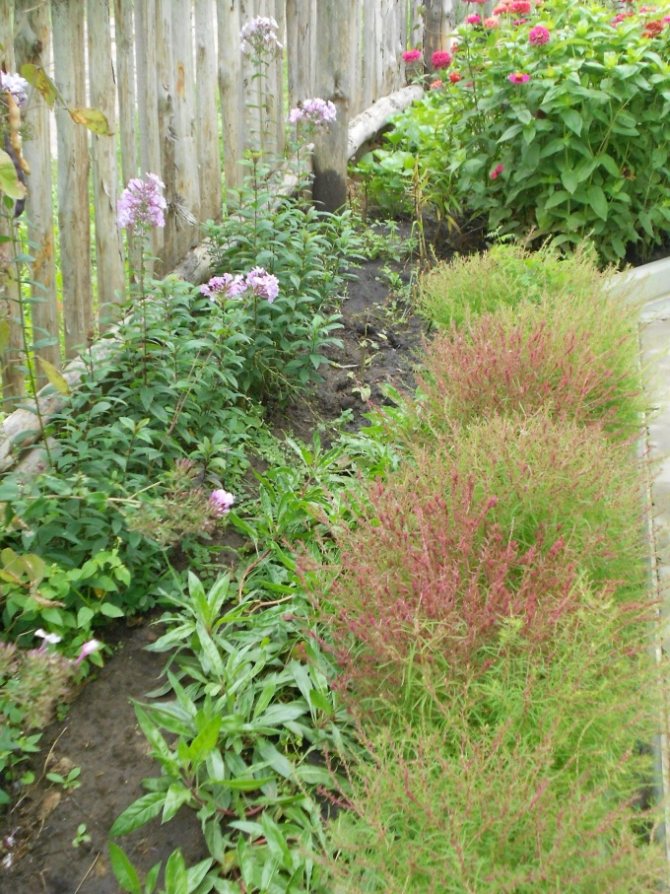

Cochia grows until late autumn. Light frosts make its foliage burgundy. Small flowers-seeds begin to ripen.
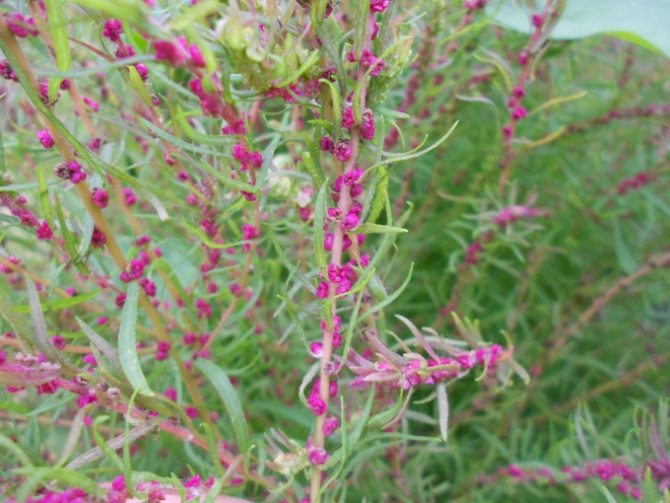

And when autumn is already a full-fledged mistress on the street, and summer flowers have long been removed, the kochia, like a queen, rises above the bare ground.
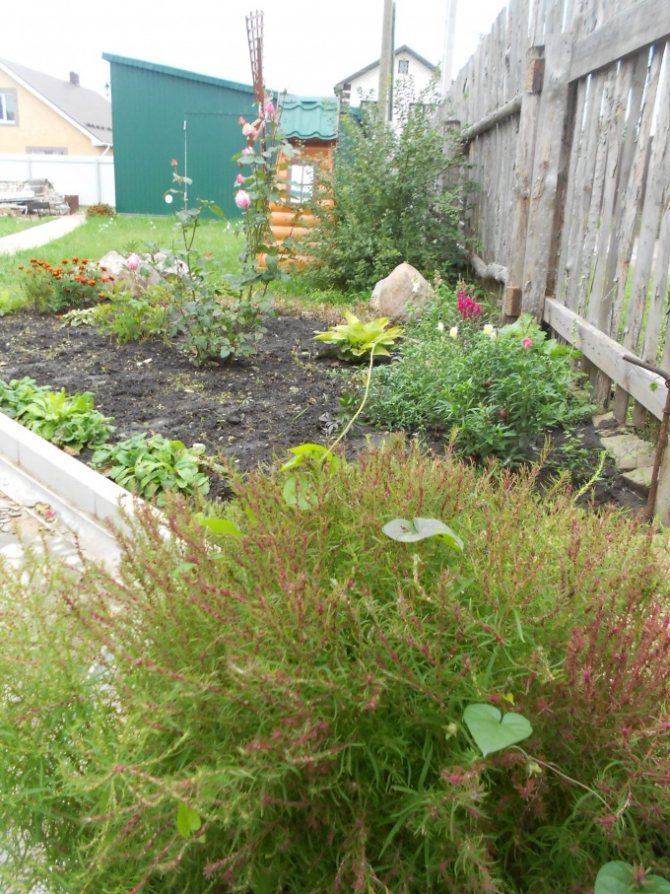

How to sow kochia seeds in the ground
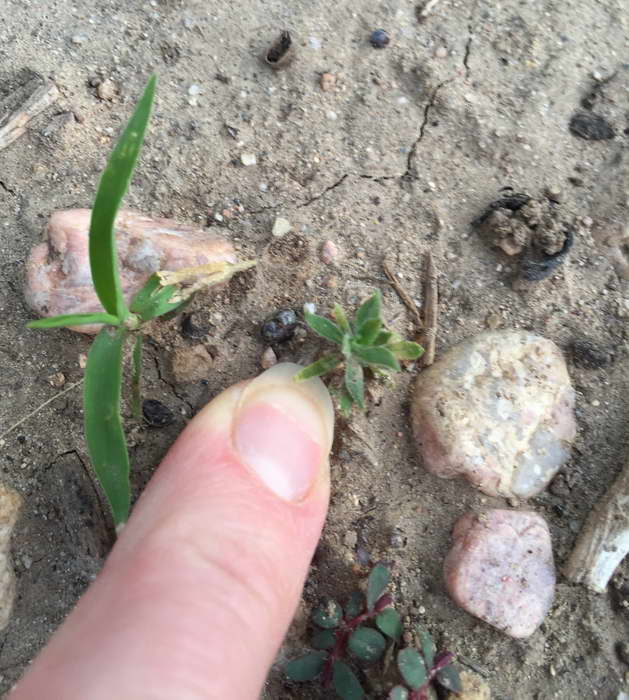

Shoots of kochia in the open field photo
It is not possible to sow seeds in open ground until April, let the temperature be set at 16 ° C.Make shallow grooves, water, sow seeds and dust with earth. If it gets colder or there is a threat of frost at night, protect the crops with foil.
The kohija bush dies off with the onset of cold weather, but manages to please with the beauty of the greenery and give self-seeding. Cover the seedlings the following spring to protect them from frost, then thin out the seedlings as needed.
Description and use of the plant
The plant has a rod-shaped root. It has a powerful structure and deep bedding, so the bush takes root firmly. The height of the kochia is about 60-80 cm. The stem is straight and has branches along its entire length. The leaves are drooping, linear, rather narrow, and sometimes filamentary. Cochia flowers are very small and are collected in spike-shaped or paniculate inflorescences. The flower is pollinated by the wind. After flowering, it forms fruits containing very small seeds. Once ripe, they are spread by the wind and begin to sprout after winter.
Cochia does not have an attractive flowering, therefore it is grown exclusively as an ornamental deciduous plant. It forms lush shrubs that lend itself well to pruning. This plant can be used as hedges, curbs and so on. The bushes can not only decorate the garden, but also be used for technical purposes, they can be used to make brooms and panicles. Some varieties of kohija are used as a forage crop for domestic animals.
Choosing a place and soil on the site
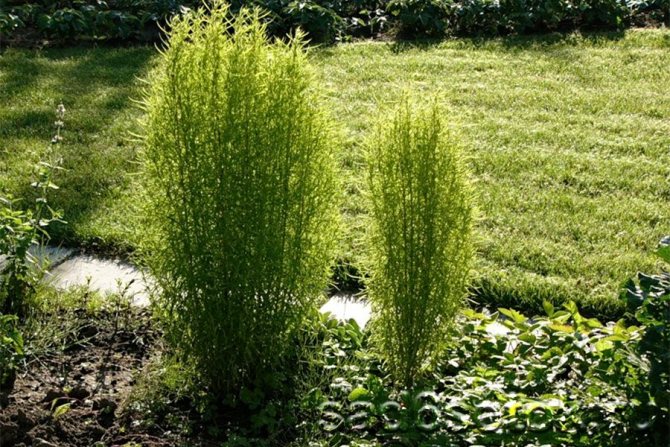

How to choose a place to plant a kochii?
Cochia sites should be sunny and sheltered from the wind. Landing in light shade is allowed. Under heavy shading, the plant will branch slightly and the leaves will turn red. Lowlands with a close occurrence of groundwater are not suitable for cultivation.
Kokhia is planted on fertile soils that allow water and air to flow well to the roots. The acidity level should be close to neutral or slightly acidic. On poor soils, the bushes are low, inconspicuous, with dull leaves.
Before planting, they dig up the earth, humus must be introduced into the soil, compost at the rate of 10 kg per 1 sq. m. or nitrogen fertilizers - ammonium nitrate, urea, ammonium sulfate.
Collection and storage of seeds
To harvest the seeds, the bushes must be fully ripe. When they become burgundy, dry out a little, you can take seed. This usually happens in October or November. The inflorescences are cut off, small seeds are taken out of them.
They should be stored in a paper or cloth envelope in a dry place, with an air temperature of up to 25 degrees Celsius..
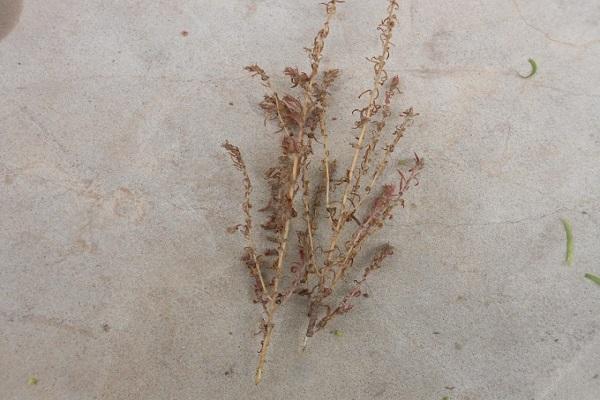

Beneficial features


Kochia has medicinal properties and is also used as a forage crop. In alternative medicine, alcoholic tinctures and decoctions are prepared from seeds and young stems, which are distinguished by a diuretic, stimulating, antimicrobial, diaphoretic, laxative and cardiotonic effect.
Means prepared on the basis of such a plant are used in the treatment of erysipelas, eczema or gonorrhea. And in oriental medicine, kohija is used to prepare a cream that can strengthen both the skin and the nail plates.
After cutting the bushes, the young stems can be fed to livestock. Kohija is used to grow silkworms on specialized farms. There are countries where young leaves of this plant are used in the preparation of first courses. And you can also get soda from such a shrub.
The use of various types of kochia in landscape design and gardening
When decorating gardens, summer cottages and various territories broom cochia often used to create a "green" hedge. For this, the plants are planted in two rows, while slightly shifted in relation to each other. Moreover, the distance between the bushes should be 15-20 cm, and between the rows 15 cm. With this planting, the fence turns out to be dense and beautiful.
Cochia broom is also often used for planting in a variety of flower and rocky compositions, as well as on alpine slides. In group plantings, combinations of multi-colored varieties are very beautiful.
Cochia hairy (garden form k. broom) is used both as a tapeworm (single plant), and to create a "green" hedge. It is interesting that this hedge in winter, when the plants are completely dry, retains its shape well and looks beautiful against the background of the snow cover. With the onset of spring, old bushes are removed and young plants are replanted.
With the help of a shearing of kohija, you can give almost any shape, for example, the plants are very decorative in the form of bright green balls.
A hedge made from Cochia Childs, also turns out to be quite dense. Plants are planted in it with an offset, the distance between them in a row is about 30 cm. Kohia Childs looks great in solitary plantings. Bushes of this species are very unpretentious to growing conditions.
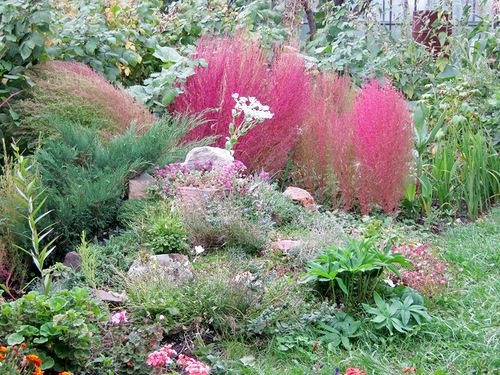

Landing rules
When growing kochia, it must be remembered that this popular ornamental crop in natural conditions prefers semi-deserts and steppes. Placing a plant in the garden involves the use of open and sunny areas with little shading.... Cochiae are not whimsical to soil composition and grow well on any cultivated soils, with the exception of too acidic and waterlogged ones. It is best to plant well-drained, loose and nutrient-rich soils that allow the kochia to branch out and thrive.
Cochia needs a sufficient amount of free space, therefore, when planting, you should adhere to a distance of 0.4-0.5 m between plants. A more constrained planting often causes a slowdown in the growth of an ornamental crop and a rapid transition to the flowering stage.
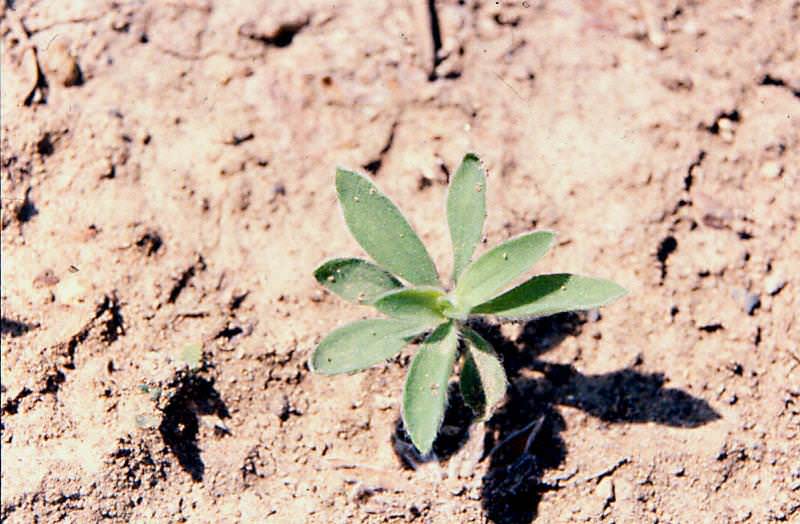

The best varieties
In the soil and climatic conditions of most regions of Russia, the most unpretentious and hardy varieties of kokhia are cultivated, which are highly decorative, and also do not require special care.
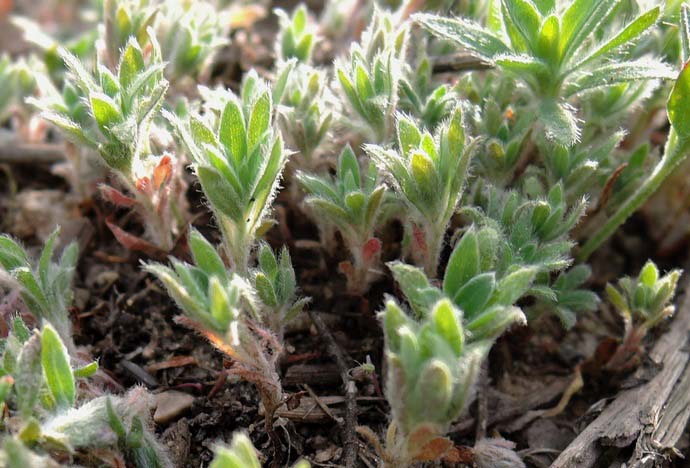

| Variety name | Botanical description | Varietal features |
| "Sultan" | Plant with a height of 0.7-1.0 m, fast growing, with emerald green foliage in summer and red leaves in autumn | Withstands regular haircuts well, unpretentious plant |
| Barning Bush | An annual shrub plant no more than a meter in height, well tolerates haircuts and retains its shape for a long time | The aerial part becomes red almost immediately after germination |
| "Nephritis" | Plant no more than 0.7-1.0 m in height.Fast-growing form with emerald green foliage in summer and red leaves in autumn | Used as a focal plant for flower beds and hedges of any configuration |
| Acapulco Silver | It has bright green leaves with silvery ends. By the fall, they turn purple. | The rarest and most amazing variety in its beauty |
| "Shilzy" | The bush is 1 m high and 0.6 m wide.Changes the green color of the foliage to a purple-red hue | Tall, bushy plant, very early begins to change the color of the foliage |
| "Green Lace" | An oval-shaped annual shrub with emerald green foliage | The plant tolerates haircuts very well, it is often used when decorating live borders |
| "The Royal Castle" | Elongated pyramidal bush up to a meter high and 0.5-0.6 m wide with small light green leaves in summer and burgundy in autumn | Cultivar that lends itself well to shearing, is resistant to diseases and pests |
| "Green Forest" | Fast-growing ornamental deciduous culture up to a meter high with highly branched shoots and numerous light green leaves | The plant tolerates haircuts very well, it is often used when decorating live borders |
| "Summer Cyprus" | Annual with a height of 0.6-1.0 m, regular elongated-oval shape, with stems covered with small, green coloration, fluffy foliage | It lends itself well to haircuts, the foliage in the fall acquires a crimson-red coloration |
| "Trichophylla" | A fast-growing and densely branching bush of oval-pyramidal shape, up to 1.5 m high, with small, narrow, graceful, red leaves in autumn | Used as a focal plant for flower beds and hedges of any configuration |
| "Flame" | An annual, fast-growing ornamental shrub up to a meter high, not flowering, in the fall it acquires a crimson coloration of the leaves | The plant retains its decorative effect from June to the onset of frost. |
Popular types
In the conditions of decorative floriculture in personal and garden plots, several unpretentious and attractive varieties of kochia, including hairy red and coronal cochia, are most widespread.
| Species name | Botanical description | Species features |
| Creeping or twig | Squat shrub with stem part strongly branching at the base | Perennial dwarf shrub with a height of no more than 0.1-0.5 m |
| Woolly-flowered | Stem part yellowish-green or with a reddish tint, covered with dense small hairs | Annual plant no more than 0.8 m high |
| Dense-flowered | Plant strongly branching at the base with numerous white-topped flowers | Annual plant up to 1.2 m high |
| Coronal or paniculate or skoparia | Ornamental-deciduous plant about a meter high, elongated-oval, with densely branched stems, small linear-lanceolate emerald green or red leaves | Annual and perennial herb and shrub |
| Kohia Childs | Compact bushy plants growing up to 0.5 m with light green foliage | The aboveground part retains a green coloration even in autumn. |
Care
Annual and perennial kokhia are drought-resistant, but you should not forget about watering. Otherwise, the plant will lose its decorative effect. Stagnant water is also destructive, so watering is carried out carefully.
Kohia can hardly bear the lack of light. The plant is planted only in sunny areas. You can feed the plant with nitrogen complexes. Fertilizer is applied every 2 weeks during the summer.
Reproduction of kochia is carried out using seeds. They have a short germination period. Half of the seeds do not live up to 2 years. It is recommended to collect them yourself from female flowers. Otherwise, the plant will multiply by self-seeding.
With the onset of autumn cold weather, the plant quickly fades. Red and green kohija dried on the vine is used as a herb for ikebana or broom.
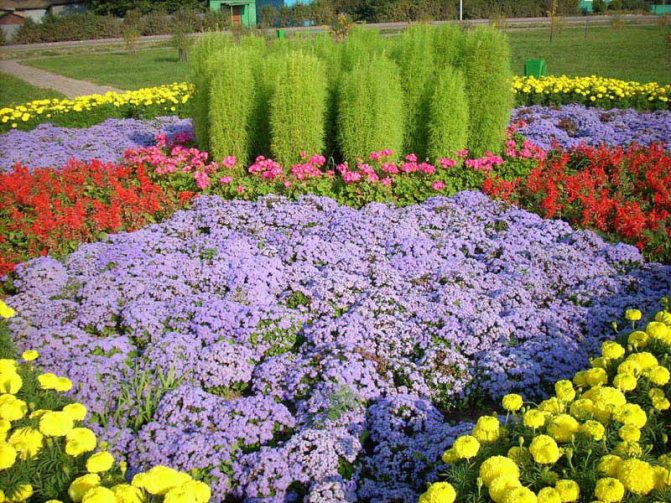

Diseases and pests
It is important for novice gardeners to know not only about how planting and growing plants in the open field is carried out. Cochia can be affected by pests such as spider mites. If a parasite is found, the plant is treated with a Neoron solution (1 ml per 1 liter of water).
Pruning
Red, green and purple cochia can be used in landscaping to create beautiful compositions. Planting for growing flower borders is also possible. Cochia tolerates pruning well. The procedure is useful for the growth of the bush. Cochia can be circumcised every 14 to 20 days.
In order for the varieties Jade, Sultan, Royal Castle, Kokhia corona (unburnt), hairy to grow well in the open field, it is important that planting and cultivation are carried out in accordance with all the rules. Outdoors, it is difficult for bushes to survive shading and stagnant water. Reproduction takes place by self-sowing, using seeds and seedlings. The bush needs nitrogen fertilization in order to feed the plant in time. A dangerous pest is a spider mite. If parasites appear, they are treated with insecticides.
general description
- Cochia is a short and lush bush.
- The plant is great for decorating flower beds, fences and borders.
- Shrub maintenance requires no skill.
- At first glance, the plant looks like a coniferous bonsai, in fact, its needles are soft and delicate.
- The height of the woody trunk is from 50 to 90 cm, the crown can be spreading.
- The color of the foliage changes - from light green and emerald, pink and crimson.
- The shrub blooms in the middle of summer, but barely noticeable buds do not cause wild admiration.
Where and how it is applied
In landscape design, kohija is widely used in the creation of hedges, as a dense green background for low-growing flowers, for topiary, and imitation of conifers in Japanese compositions. Some varieties in the fall change the color of the leaves from green to bright yellow or purple. Looks impressively as the only tall and large specimen in a flower bed with ground cover plants. Low-growing varieties adorn flowerpots, in combination with viola, geranium, violets. A group of kokhias, planted against the background of a rocky wall or several large boulders, looks very harmonious.
Previously, a fast-growing and densely leafy twig was planted to obtain material for the manufacture of brooms.
What does kochia look like?
Cochia has many small leaves, which in large volumes can safely resemble a cypress. The name of this wonderful plant comes from a German philosopher who made great strides in botany and recognition of plants and flowers.
There are 2 types of kochia that differ from each other - light cypress and bass. They differ only in appearance, namely in the section of the sheets. Some species even resemble a pyramid-shaped tree crown. Some peoples call this plant herb because they use this delicious plant for brooms.
You will be interested in: How to arrange a long and narrow suburban area, landscape design
Photo of kohija:
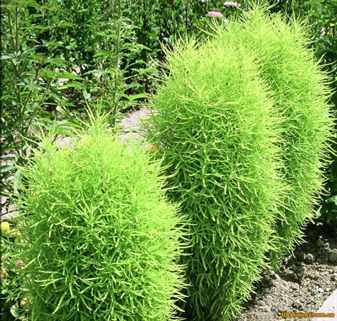

A haircut
But in addition to long decorativeness and unpretentiousness, she has one more quality for which I appreciate her. Kohia has a beautiful haircut and can be used to depict bizarre figures.
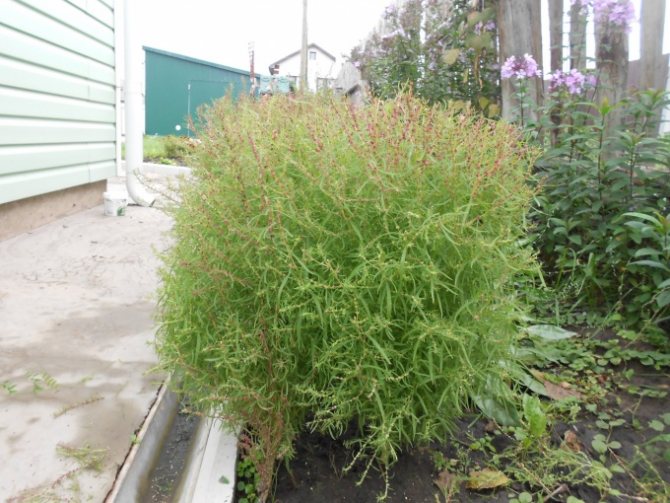

Of course, I'm not a designer, but when the kochia border is trimmed exactly, the garden acquires a certain neatness, the kochia flower bed looks complete. My flower beds do not convey all the beauty of kokhiy. See what landscape designers make of it. These are borders and solo compositions.
The flowers of the kochia are inconspicuous, but the decorative foliage and the shape of the plant more than compensate for this disadvantage. And as a bonus to beauty, you will receive an environmentally friendly broom, which, after repeated use, can be sent to compost without a twinge of conscience.
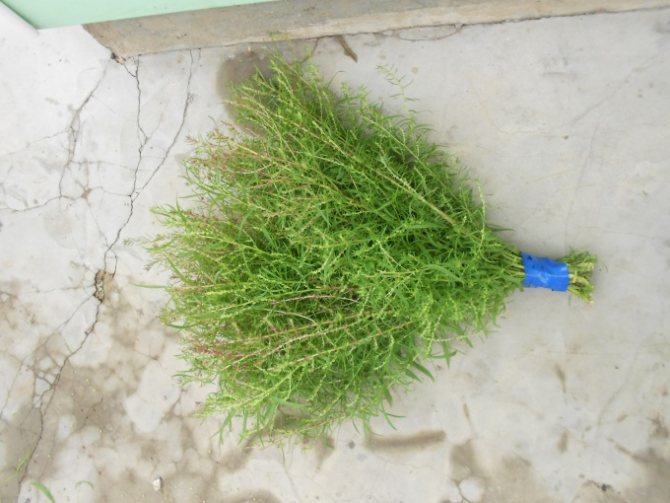

I hope that you are interested in my story and this bright plant will be added to your garden wishes.
Gallery: perennial kochia (25 photos)
Cochia - 50 fresh photos of examples of care and cultivation
Picking, feeding and disembarkation
So that the kochia bush does not grow too fluffy, retains its compactness and neat appearance, the seedlings should be dived into separate pots 10 cm in diameter. They are transplanted 2-3 weeks after the sprouts appear, with at least 2 leaves on them. Containers and soil are disinfected. Three seedlings are placed in each pot. Subsequently, the weak are removed, and the strong are left for disembarkation. The containers are placed in the brightest place.
The sprouts must be fed three times before planting in open ground. For the first time, a complex fertilizer is used for seedlings a few days after the dive. The next dressings are carried out after 2 weeks, using also a complex agent in which nitrogen predominates.
You can plant seedlings in open ground in mid-May, but it is advisable to wait until the end of the month. The place is chosen sunny, without drafts. The soil should be loose, fertile and not waterlogged.If the sprouts are planted in an ordinary flower garden, then the distance between them should be 30 cm, and if the plant is used as a low hedge or curb, then 15 cm. While the bushes are rooting, they are watered abundantly, and after 2 weeks they are fed. Then the first haircut is carried out and fertilizers are applied again.
Summer cypress colors
Most often, this plant can be found in a green color, which it keeps perfectly throughout the spring, and then summer, and by autumn it changes its color to yellow.
Some varieties can even get a reddish tint. Kokhia branches twist a little. They grow one summer and can reach a height of one and a half meters. This plant at maturity looks very impressive and can emphasize both the style of the yard and its interior.
It can be safely planted near the gazebo or at the entrance to the courtyard. Thus, the front part of the house will be beautifully highlighted, which is considered the most beautiful place.

